Establish an Effective IT Steering Committee

- Unfortunately, when CIOs implement IT steering committees, they often lack the appropriate structure and processes to be effective.
- Due to the high profile of the IT steering committee membership, CIOs need to get this right – or their reputation is at risk.
Our Advice
Critical Insight
- 88% of IT steering committees fail. The organizations that succeed have clearly defined responsibilities that are based on business needs.
- Without a documented process your committee can’t execute on its responsibilities. Clearly define the flow of information to make your committee actionable.
- Limit your headaches by holding your IT steering committee accountable for defining project prioritization criteria.
Impact and Result
Leverage Info-Tech’s process and deliverables to see dramatic improvements in your business satisfaction through an effective IT steering committee. This blueprint will provide three core customizable deliverables that you can use to launch or optimize your IT steering committee:
- IT Steering Committee Charter: Use this template in combination with this blueprint to form a highly tailored committee.
- IT Steering Committee Stakeholder Presentation: Build understanding around the goals and purpose of the IT steering committee, and generate support from your leadership team.
- IT Steering Committee Project Prioritization Tool: Engage your IT steering committee participants in defining project prioritization criteria. Track project prioritization and assess your portfolio.
Establish an Effective IT Steering Committee Research & Tools
Start here – read the Executive Brief
Read our concise Executive Brief to find out why you should establish an IT steering committee, review Info-Tech’s methodology, and understand the ways we can support you in completing this project.Besides the small introduction, subscribers and consulting clients within this management domain have access to:
- Establish an Effective IT Steering Committee – Phases 1-4
1. Build the steering committee charter
Build your IT steering committee charter using results from the stakeholder survey.
- Establish an Effective IT Steering Committee – Phase 1: Build the Steering Committee Charter
- IT Steering Committee Stakeholder Survey
- IT Steering Committee Charter
2. Define IT steering commitee processes
Define your high level steering committee processes using SIPOC, and select your steering committee metrics.
- Establish an Effective IT Steering Committee – Phase 2: Define ITSC Processes
3. Build the stakeholder presentation
Customize Info-Tech’s stakeholder presentation template to gain buy-in from your key IT steering committee stakeholders.
- Establish an Effective IT Steering Committee – Phase 3: Build the Stakeholder Presentation
- IT Steering Committee Stakeholder Presentation
4. Define the prioritization criteria
Build the new project intake and prioritization process for your new IT steering committee.
- Establish an Effective IT Steering Committee – Phase 4: Define the Prioritization Criteria
- IT Steering Committee Project Prioritization Tool
- IT Project Intake Form
Workshop: Establish an Effective IT Steering Committee
Workshops offer an easy way to accelerate your project. If you are unable to do the project yourself, and a Guided Implementation isn't enough, we offer low-cost delivery of our project workshops. We take you through every phase of your project and ensure that you have a roadmap in place to complete your project successfully.
1 Build the IT Steering Committee
The Purpose
Lay the foundation for your IT steering committee (ITSC) by surveying your stakeholders and identifying the opportunities and threats to implementing your ITSC.
Key Benefits Achieved
An understanding of the business environment affecting your future ITSC and identification of strategies for engaging with stakeholders
Activities
1.1 Launch stakeholder survey for business leaders.
1.2 Analyze results with an Info-Tech advisor.
1.3 Identify opportunities and threats to successful IT steering committee implementation.
1.4 Develop the fit-for-purpose approach.
Outputs
Report on business leader governance priorities and awareness
Refined workshop agenda
2 Define the ITSC Goals
The Purpose
Define the goals and roles of your IT steering committee.
Plan the responsibilities of your future committee members.
Key Benefits Achieved
Groundwork for completing the steering committee charter
Activities
2.1 Review the role of the IT steering committee.
2.2 Identify IT steering committee goals and objectives.
2.3 Conduct a SWOT analysis on the five governance areas
2.4 Define the key responsibilities of the ITSC.
2.5 Define ITSC participation.
Outputs
IT steering committee key responsibilities and participants identified
IT steering committee priorities identified
3 Define the ITSC Charter
The Purpose
Document the information required to create an effective ITSC Charter.
Create the procedures required for your IT steering committee.
Key Benefits Achieved
Clearly defined roles and responsibilities for your steering committee
Completed IT Steering Committee Charter document
Activities
3.1 Build IT steering committee participant RACI.
3.2 Define your responsibility cadence and agendas.
3.3 Develop IT steering committee procedures.
3.4 Define your IT steering committee purpose statement and goals.
Outputs
IT steering committee charter: procedures, agenda, and RACI
Defined purpose statement and goals
4 Define the ITSC Process
The Purpose
Define and test your IT steering committee processes.
Get buy-in from your key stakeholders through your stakeholder presentation.
Key Benefits Achieved
Stakeholder understanding of the purpose and procedures of IT steering committee membership
Activities
4.1 Define your high-level IT steering committee processes.
4.2 Conduct scenario testing on key processes, establish ITSC metrics.
4.3 Build your ITSC stakeholder presentation.
4.4 Manage potential objections.
Outputs
IT steering committee SIPOC maps
Refined stakeholder presentation
5 Define Project Prioritization Criteria
The Purpose
Key Benefits Achieved
Activities
5.1 Create prioritization criteria
5.2 Customize the project prioritization tool
5.3 Pilot test the tool
5.4 Define action plan and next steps
Outputs
IT Steering Committee Project Prioritization Tool
Action plan
Further reading
Establish an Effective IT Steering Committee
Have the right people making the right decisions to drive IT success.
Our understanding of the problem
This Research Is Designed For:
- CIOs
- IT Leaders
This Research Will Also Assist:
- Business Partners
This Research Will Help You:
- Structure an IT steering committee with the appropriate membership and responsibilities
- Define appropriate cadence around business involvement in IT decision making
- Define your IT steering committee processes, metrics, and timelines
- Obtain buy-in for IT steering committee participations
- Define the project prioritization criteria
This Research Will Help Them:
- Understand the importance of IT governance and their role
- Identify and build the investment prioritization criteria
Executive Summary
Situation
- An effective IT steering committee (ITSC) is one of the top predictors of value generated by IT, yet only 11% of CIOs believe their committees are effective.
- An effective steering committee ensures that the right people are involved in critical decision making to drive organizational value.
Complication
- Unfortunately, when CIOs do implement IT steering committees, they often lack the appropriate structure and processes to be effective.
- Due to the high profile of the IT steering committee membership, CIOs need to get this right – or their reputation is at risk.
Resolution
Leverage Info-Tech’s process and deliverables to see dramatic improvements in your business satisfaction through an effective IT steering committee. This blueprint will provide three core customizable deliverables that you can use to launch or optimize your IT steering committee. These include:
- IT Steering Committee Charter: Customizable charter complete with example purpose, goals, responsibilities, procedures, RACI, and processes. Use this template in combination with this blueprint to get a highly tailored committee.
- IT Stakeholder Presentation: Use our customizable presentation guide to build understanding around the goals and purpose of the IT steering committee and generate support from your leadership team.
- IT Steering Committee Project Prioritization Tool: Engage your IT steering committee participants in defining the project prioritization criteria. Use our template to track project prioritization and assess your portfolio.
Info-Tech Insight
- 88% of IT steering committees fail. The organizations that succeed have clearly defined responsibilities that are based on business needs.
- Without a documented process your committee can’t execute on its responsibilities. Clearly define the flow of information to make your committee actionable.
- Limit your headaches by holding your IT steering committee accountable for defining project prioritization criteria.
IT Steering Committee
Effective IT governance critical in driving business satisfaction with IT. Yet 88% of CIOs believe that their governance structure and processes are not effective. The IT steering committee (ITSC) is the heart of the governance body and brings together critical organizational stakeholders to enable effective decision making (Info-Tech Research Group Webinar Survey).
IT STEERING COMMITTEES HAVE 3 PRIMARY OBJECTIVES – TO IMPROVE:
- Alignment: IT steering committees drive IT and business strategy alignment by having business partners jointly accountable for the prioritization and selection of projects and investments within the context of IT capacity.
- Accountability: The ITSC facilitates the involvement and commitment of executive management through clearly defined roles and accountabilities for IT decisions in five critical areas: investments, projects, risk, services, and data.
- Value Generation: The ITSC is responsible for the ongoing evaluation of IT value and performance of IT services. The committee should define these standards and approve remediation plans when there is non-achievement.
"Everyone needs good IT, but no one wants to talk about it. Most CFOs would rather spend time with their in-laws than in an IT steering-committee meeting. But companies with good governance consistently outperform companies with bad. Which group do you want to be in?"
– Martha Heller, President, Heller Search Associates
An effective IT steering committee improves IT and business alignment and increases support for IT across the organization
CEOs’ PERCEPTION OF IT AND BUSINESS ALIGNMENT
67% of CIOs/CEOs are misaligned on the target role for IT.
47% of CEOs believe that business goals are going unsupported by IT.
64% of CEOs believe that improvement is required around IT’s understanding of business goals.
28% of business leaders are supporters of their IT departments.
A well devised IT steering committee ensures that core business partners are involved in critical decision making and that decisions are based on business goals – not who shouts the loudest. Leading to faster decision-making time, and better-quality decisions and outcomes.
Source: Info-Tech CIO/CEO Alignment data
Despite the benefits, 9 out of 10 steering committees are unsuccessful
WHY DO IT STEERING COMMITTEES FAIL?
- A lack of appetite for an IT steering committee from business partners An effective ITSC requires participation from core members of the organization’s leadership team. The challenge is that most business partners don’t understand the benefits of an ITSC and the responsibilities aren’t tailored to participants’ needs or interests. It’s the CIOs responsibility to make this case to stakeholders and right-size the committee responsibilities and membership.
- IT steering committees are given inappropriate responsibilities The IT steering committee is fundamentally about decision making; it’s not a working committee. CIOs struggle with clarifying these responsibilities on two fronts: either the responsibilities are too vague and there is no clear way to execute on them within a meeting, or responsibilities are too tactical and require knowledge that participants do not have. Responsibilities should determine who is on the ITSC, not the other way around.
- Lack of process around execution An ITSC is only valuable if members are able to successfully execute on the responsibilities. Without well defined processes it becomes nearly impossible for the ITSC to be actionable. As a result, participants lack the information they need to make critical decisions, agendas are unmet, and meetings are seen as a waste of time.
GOVERNANCE and ITSC and IT Management
Organizations often blur the line between governance and management, resulting in the business having say over the wrong things. Understand the differences and make sure both groups understand their role.
The ITSC is the most senior body within the IT governance structure, involving key business executives and focusing on critical strategic decisions impacting the whole organization.
Within a holistic governance structure, organizations may have additional committees that evaluate, direct, and monitor key decisions at a more tactical level and report into the ITSC.
These committees require specialized knowledge and are implemented to meet specific organizational needs. Those operational committees may spark a tactical task force to act on specific needs.
IT management is responsible for executing on, running, and monitoring strategic activities as determined by IT governance.
RELATIONSHIP BETWEEN STRATEGIC, TACTICAL, AND OPERATIONAL GROUPS
| Strategic | IT Steering Committee | |
| Tactical | Project Governance Service Governance Risk Governance Information Governance |
IT Management |
| Operational | Risk Task Force |
This blueprint focuses exclusively on building the IT steering committee. For more information on IT governance see Info-Tech’s blueprint Tailor an IT Governance Plan to Fit Organizational Needs.
- Governance of the IT Portfolio & Investments: ensures that funding and resources are systematically allocated to the priority projects that deliver value
- Governance of Projects: ensures that IT projects deliver the expected value, and that the PM methodology is measured and effective.
- Governance of Risks: ensures the organization’s ability to assess and deliver IT projects and services with acceptable risk.
- Governance of Services: ensures that IT delivers the required services at the acceptable performance levels.
- Governance of Information and Data: ensures the appropriate classification and retention of data based on business need.
If these symptoms resonate with you, it might be time to invest in building an IT steering committee
SIGNS YOU MAY NEED TO BUILD AN IT STEERING COMMITTEE
| As CIO I find that there is a lack of alignment between business and IT strategies. |
| I’ve noticed that projects are thrown over the fence by stakeholders and IT is expected to comply. |
| I’ve noticed that IT projects are not meeting target project metrics. |
| I’ve struggled with a lack of accountability for decision making, especially by the business. |
| I’ve noticed that the business does not understand the full cost of initiatives and projects. |
| I don’t have the authority to say “no” when business requests come our way. |
| We lack a standardized approach for prioritizing projects. |
| IT has a bad reputation within the organization, and I need a way to improve relationships. |
| Business partners are unaware of how decisions are made around IT risks. |
| Business partners don’t understand the full scope of IT responsibilities. |
| There are no SLAs in place and no way to measure stakeholder satisfaction with IT. |
Info-Tech’s approach to implementing an IT steering committee
Info-Tech’s IT steering committee development blueprint will provide you with the required tools, templates, and deliverables to implement a right-sized committee that’s effective the first time.
- Measure your business partner level of awareness and interest in the five IT governance areas, and target specific responsibilities for your steering committee based on need.
- Customize Info-Tech’s IT Steering Committee Charter Template to define and document the steering committee purpose, responsibilities, participation, and cadence.
- Build critical steering committee processes to enable information to flow into and out of the committee to ensure that the committee is able to execute on responsibilities.
- Customize Info-Tech’s IT Steering Committee Stakeholder Presentation template to make your first meeting a breeze, providing stakeholders with the information they need, with less than two hours of preparation time.
- Leverage our workshop guide and prioritization tools to facilitate a meeting with IT steering committee members to define the prioritization criteria for projects and investments and roll out a streamlined process.
Info-Tech’s Four-Phase Process
Key Deliverables:| 1 | 2 | 3 | 4 |
| Build the Steering Committee Charter | Define ITSC Processes | Build the Stakeholder Presentation | Define the Prioritization Criteria |
|
|
|
|
Leverage both COBIT and Info-Tech-defined metrics to evaluate the success of your program or project
| COBIT METRICS | Alignment
|
Accountability
|
Value Generation
|
| INFO-TECH METRICS | Survey Metrics:
|
CASE STUDY
Industry: Consumer Goods
Source: Interview
Situation
A newly hired CIO at a large consumer goods company inherited an IT department with low maturity from her predecessor. Satisfaction with IT was very low across all business units, and IT faced a lot of capacity constraints. The business saw IT as a bottleneck or red tape in terms of getting their projects approved and completed.
The previous CIO had established a steering committee for a short time, but it had a poorly established charter that did not involve all of the business units. Also the role and responsibilities of the steering committee were not clearly defined. This led the committee to be bogged down in politics.
Due to the previous issues, the business was wary of being involved in a new steering committee. In order to establish a new steering committee, the new CIO needed to navigate the bad reputation of the previous CIO.
Solution
The CIO established a new steering committee engaging senior members of each business unit. The roles of the committee members were clearly established in the new steering committee charter and business stakeholders were informed of the changes through presentations.
The importance of the committee was demonstrated through the new intake and prioritization process for projects. Business stakeholders were impressed with the new process and its transparency and IT was no longer seen as a bottleneck.
Results
- Satisfaction with IT increased by 12% after establishing the committee and IT was no longer seen as red tape for completing projects
- IT received approval to hire two more staff members to increase capacity
- IT was able to augment service levels, allowing them to reinvest in innovative projects
- Project prioritization process was streamlined
Info-Tech offers various levels of support to best suit your needs
DIY Toolkit
“Our team has already made this critical project a priority, and we have the time and capability, but some guidance along the way would be helpful.”
Guided Implementation
“Our team knows that we need to fix a process, but we need assistance to determine where to focus. Some check-ins along the way would help keep us on track.”
Workshop
“We need to hit the ground running and get this project kicked off immediately. Our team has the ability to take this over once we get a framework and strategy in place.”
Consulting
“Our team does not have the time or the knowledge to take this project on. We need assistance through the entirety of this project.”
Diagnostics and consistent frameworks used throughout all four options
Establish an Effective IT Steering Committee
| Build the Steering Committee Charter | Define ITSC Processes | Build the Stakeholder Presentation | Define the Prioritization Criteria | |
|---|---|---|---|---|
| Best-Practice Toolkit | 1.1 Survey Your Steering Committee Stakeholders 1.2 Build Your ITSC Charter |
2.1 Build a SIPOC 2.2 Define Your ITSC Process |
3.1 Customize the Stakeholder Presentation | 4.1 Establish your Prioritization Criteria 4.2 Customize the Project Prioritization Tool 4.3 Pilot Test Your New Prioritization Criteria |
| Guided Implementations |
|
|
|
|
| Onsite Workshop | Module 1: Build a New ITSC Charter |
Module 2: Design Steering Committee Processes |
Module 3: Present the New Steering Committee to Stakeholders |
Module 4: Establish Project Prioritization Criteria |
Phase 1 Results:
|
Phase 2 Results:
|
Phase 3 Results:
|
Phase 4 Results:
|
Workshop overview
Contact your account representative or email Workshops@InfoTech.com for more information.
| Workshop Day 1 | Workshop Day 2 | Workshop Day 3 | Workshop Day 4 | Workshop Day 5 | |
|---|---|---|---|---|---|
| Activities | Build the IT Steering Committee 1.1 Launch stakeholder survey for business leaders 1.2 Analyze results with an Info-Tech Advisor 1.3 Identify opportunities and threats to successful IT steering committee implementation. 1.4 Develop the fit-for-purpose approach |
Define the ITSC Goals 2.1 Review the role of the IT steering committee 2.2 Identify IT steering committee goals and objectives 2.3 Conduct a SWOT analysis on the five governance areas 2.4 Define the key responsibilities of the ITSC 2.5 Define ITSC participation |
Define the ITSC Charter 3.1 Build IT steering committee participant RACI 3.2 Define your responsibility cadence and agendas 3.3 Develop IT steering committee procedures 3.4 Define your IT steering committee purpose statement and goals |
Define the ITSC Process 4.1 Define your high-level IT steering committee processes 4.2 Conduct scenario testing on key processes, establish ITSC metrics 4.3 Build your ITSC stakeholder presentation 4.4 Manage potential objections |
Define Project Prioritization Criteria 5.1 Create prioritization criteria 5.2 Customize the Project Prioritization Tool 5.3 Pilot test the tool 5.4 Define action plan and next steps |
| Deliverables |
|
|
|
|
|
Phase 1
Build the IT Steering Committee Charter
Phase 1 outline
Call 1-888-670-8889 or email GuidedImplementations@InfoTech.com for more information.
Complete these steps on your own, or call us to complete a guided implementation. A guided implementation is a series of 2-3 advisory calls that help you execute each phase of a project. They are included in most advisory memberships.
|
Guided Implementation 1: Formalize the Security Policy Program Proposed Time to Completion: 1-2 weeks |
|---|
Select Your ITSC Members Start with an analyst kick-off call:
Then complete these activities…
With these tools & templates:
|
Review Stakeholder Survey Results Review findings with analyst:
Then complete these activities…
With these tools & templates:
|
Finalize the ITSC Charter Finalize phase deliverable:
Then complete these activities…
With these tools & templates:
|
Build the IT Steering Committee Charter
This step will walk you through the following activities:
- Launch and analyze the stakeholder survey
- Define your ITSC goals and purpose statement
- Determine ITSC responsibilities and participants
- Determine ITSC procedures
This step involves the following participants:
- CIO
- IT Steering Committee
- IT Leadership Team
- PMO
Key Insight:
Be exclusive with your IT steering committee membership. Determine committee participation based on committee responsibilities. Select only those who are key decision makers for the activities the committee is responsible for and, wherever possible, keep membership to 5-8 people.
Tailor Info-Tech’s IT Steering Committee Charter Template to define terms of reference for the ITSC
1.1
A charter is the organizational mandate that outlines the purpose, scope, and authority of the ITSC. Without a charter, the steering committee’s value, scope, and success criteria are unclear to participants, resulting in unrealistic stakeholder expectations and poor organizational acceptance.
Start by reviewing Info-Tech’s template. Throughout this section we will help you to tailor its contents.
Committee Purpose: The rationale, benefits of, and overall function of the committee.
Responsibilities: What tasks/decisions the accountable committee is making.
Participation: Who is on the committee
RACI: Who is accountable, responsible, consulted, and informed regarding each responsibility.
Committee Procedures and Agendas: Includes how the committee will be organized and how the committee will interact and communicate with business units.
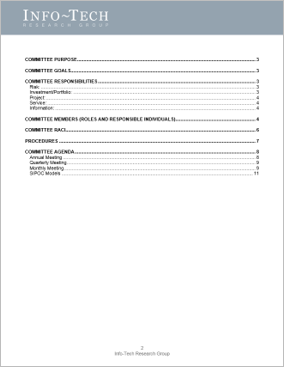 IT Steering Committee Charter Template.">
IT Steering Committee Charter Template.">
Take a data-driven approach to build your IT steering committee based on business priorities
1.2
Leverage Info-Tech’s IT Steering Committee Stakeholder Surveyand reports to quickly identify business priorities and level of understanding of how decisions are made around the five governance areas.
Use these insights to drive the IT steering committee responsibilities, participation, and communication strategy.
The Stakeholder Survey consists of 17 questions on:
- Priority governance areas
- Desired level of involvement in decision making in the five governance areas
- Knowledge of how decisions are made
- Five open-ended questions on improvement opportunities
To simplify your data collection and reporting, Info-Tech can launch a web-based survey, compile the report data and assist in the data interpretation through one of our guided implementations.
Also included is a Word document with recommended questions, if you prefer to manage the survey logistics internally.
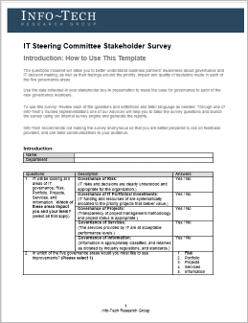 IT Steering Committee Stakeholder Survey ">
IT Steering Committee Stakeholder Survey ">
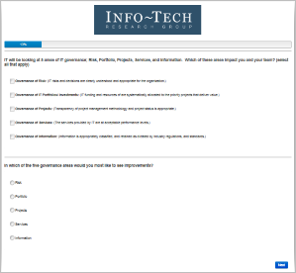
Leverage governance reports to define responsibilities and participants, and in your presentation to stakeholders
1.3
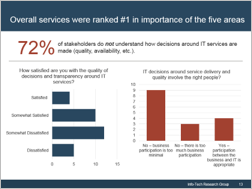 understand how decisions around IT services are made (quality, availability, etc.). Two graphs are included in the screenshot. One of the bar graphs shows the satisfaction with the quality of decisions and transparency around IT services. The other bar graph displays IT decisions around service delivery and quality that involve the right people.">
understand how decisions around IT services are made (quality, availability, etc.). Two graphs are included in the screenshot. One of the bar graphs shows the satisfaction with the quality of decisions and transparency around IT services. The other bar graph displays IT decisions around service delivery and quality that involve the right people.">
OVERALL PRIORITIES
You get:
- A clear breakdown of stakeholders’ level of understanding on how IT decisions are made in the five governance areas
- Stakeholder perceptions on the level of IT and business involvement in decision making
- Identification of priority areas
So you can:
- Get an overall pulse check for understanding
- Make the case for changes in decision-making accountability
- Identify which areas the IT steering committee should focus on
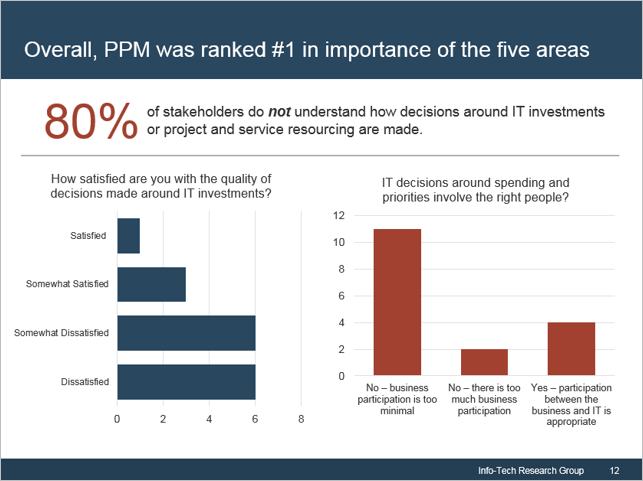 not understand how decisions around IT investments or project and service resourcing are made. Two bar graphs are displayed. One of the bar graphs shows the satisfaction with the quality of decisions made around IT investments. The other graph display IT decisions around spending priorities involving the right people.">
not understand how decisions around IT investments or project and service resourcing are made. Two bar graphs are displayed. One of the bar graphs shows the satisfaction with the quality of decisions made around IT investments. The other graph display IT decisions around spending priorities involving the right people.">
GOVERNANCE AREA REPORTS
You get:
- Satisfaction score for decision quality in each governance area
- Breakdown of decision-making accountability effectiveness
- Identified level of understanding around decision making
- Open-ended comments
So you can:
- Identify the highest priority areas to change.
- To validate changes in decision-making accountability
- To understand business perspectives on decision making.
Conduct a SWOT analysis of the five governance areas
1.4
- Hold a meeting with your IT leadership team to conduct a SWOT analysis on each of the five governance areas. Start by printing off the following five slides to provide participants with examples of the role of governance and the symptoms of poor governance in each area.
- In groups of 1-2 people, have each group complete a SWOT analysis for one of the governance areas. For each consider:
- Strengths: What is currently working well in this area?
- Weaknesses: What could you improve? What are some of the challenges you’re experiencing?
- Opportunities: What are some organizational trends that you can leverage? Consider whether your strengths or weaknesses that could create opportunities?
- Threats: What are some key obstacles across people, process, and technology?
INPUT
- Survey outcomes
- Governance overview handouts
OUTPUT
- SWOT analysis
- Ranked 5 areas
- Top 10 challenges and opportunities identified.
Materials
- Governance handouts
- Flip chart paper, pens
Participants
- IT leadership team
Governance of RISK
Governance of risk establishes the risk framework, establishes policies and standards, and monitors risks.
Governance of risk ensures that IT is mitigating all relevant risks associated with IT investments, projects, and services.
GOVERNANCE ROLES:
- Defines responsibility and accountability for IT risk identification and mitigation.
- Ensures the consideration of all elements of IT risk, including value, change, availability, security, project, and recovery
- Enables senior management to make better IT decisions based on the evaluation of the risks involved
- Facilitates the identification and analysis of IT risk and ensures the organization’s informed response to that risk.
Symptoms of poor governance of risk
- Opportunities for value creation are missed by not considering or assessing IT risk, or by completely avoiding all risk.
- No formal risk management process or accountabilities exist.
- There is no business continuity strategy.
- Frequent security breaches occur.
- System downtime occurs due to failed IT changes.
Governance of PPM
Governance of the IT portfolio achieves optimum ROI through prioritization, funding, and resourcing.
PPM practices create value if they maximize the throughput of high-value IT projects at the lowest possible cost. They destroy value when they foster needlessly sophisticated and costly processes.
GOVERNANCE ROLES:
- Ensures that the projects that deliver greater business value get a higher priority.
- Provides adequate funding for the priority projects and ensures adequate resourcing and funding balanced across the entire portfolio of projects.
- Makes the business and IT jointly accountable for setting project priorities.
- Evaluate, direct, and monitor IT value metrics and endorse the IT strategy and monitor progress.
Symptoms of poor governance of PPM/investments
- The IT investment mix is determined solely by Finance and IT.
- It is difficult to get important projects approved.
- Projects are started then halted, and resources are moved to other projects.
- Senior management has no idea what projects are in the backlog.
- Projects are approved without a valid business case.
Governance of PROJECTS
Governance of projects improves the quality and speed of decision making for project issues.
Don’t confuse project governance and management. Governance makes the decisions regarding allocation of funding and resources and reviews the overall project portfolio metrics and process methodology.
Management ensures the project deliverables are completed within the constraints of time, budget, scope, and quality.
GOVERNANCE ROLES:
- Monitors and evaluates the project management process and critical project methodology metrics.
- Ensures review and mitigation of project issue and that management is aware of projects in crisis.
- Ensures that projects beginning to show characteristics of failure cannot proceed until issues are resolved.
- Endorses the project risk criteria, and monitors major risks to project completion.
- Approves the launch and execution of projects.
Symptoms of poor governance of projects
- Projects frequently fail or get cancelled.
- Project risks and issues are not identified or addressed.
- There is no formal project management process.
- There is no senior stakeholder responsible for making project decisions.
- There is no formal project reporting.
Governance of SERVICES
Governance of services ensures delivery of a highly reliable set of IT services.
Effective governance of services enables the business to achieve the organization’s goals and strategies through the provision of reliable and cost-effective services.
GOVERNANCE ROLES:
- Ensures the satisfactory performance of those services critical to achieving business objectives.
- Monitors and directs changes in service levels.
- Ensures operational and performance objectives for IT services are met.
- Approves policy and standards on the service portfolio.
Symptoms of poor governance of service
- There is a misalignment of business needs and expectations with IT capability.
- No metrics are reported for IT services.
- The business is unaware of the IT services available to them.
- There is no accountability for service level performance.
- There is no continuous improvement plan for IT services.
- IT services or systems are frequently unavailable.
- Business satisfaction with IT scores are low.
Governance of INFORMATION
Governance of information ensures the proper handling of data and information.
Effective governance of information ensures the appropriate classification, retention, confidentiality, integrity, and availability of data in line with the needs of the business.
GOVERNANCE ROLES:
- Ensures the information lifecycle owner and process are defined and endorse by business leadership.
- Ensures the controlled access to a comprehensive information management system.
- Ensures knowledge, information, and data are gathered, analyzed, stored, shared, used, and maintained.
- Ensures that external regulations are identified and met.
Symptoms of poor governance of information
- There is a lack of clarity around data ownership, and data quality standards.
- There is insufficient understanding of what knowledge, information, and data are needed by the organization.
- There is too much effort spent on knowledge capture as opposed to knowledge transfer and re-use.
- There is too much focus on storing and sharing knowledge and information that is not up to date or relevant.
- Personnel see information management as interfering with their work.
Identify the responsibilities of the IT steering committee
1.5
- With your IT leadership team, review the typical responsibilities of the IT steering committee on the following slide.
- Print off the following slide, and in your teams of 1-2 have each group identify which responsibilities they believe the IT steering committee should have, brainstorm any additional responsibilities, and document their reasoning.
- Have each team present to the larger group, track the similarities and differences between each of the groups, and come to consensus on the list of responsibilities.
- Complete a sanity check – review your swot analysis and survey results. Do the responsibilities you’ve identified resolve the critical challenges or weaknesses?
- As a group, consider the responsibilities and consider whether you can reasonably implement those in one year, or if there are any that will need to wait until year two of the IT steering committee.
- Modify the list of responsibilities in Info-Tech’s IT Steering Committee Charter by deleting the responsibilities you do not need and adding any that you identified in the process.
Note: The bolded responsibilities are the ones that are most common to IT steering committees, and greyed out responsibilities are typical of a larger governance structure. Depending on their level of importance to your organization, you may choose to include the responsibility.
INPUT
- SWOT analysis
- Survey reports
OUTPUT
- Defined ITSC responsibilities documented in the ITSC Charter
Materials
- Responsibilities handout
- Voting dots
Participants
- IT leadership team
Typical IT steering committee and governance responsibilities
The bolded responsibilities are those that are most common to IT steering committees, and responsibilities listed in grey are typical of a larger governance structure.
INVESTMENTS / PPM
- Establish the target investment mix
- Evaluate and select programs/projects to fund
- Monitor IT value metrics
- Endorse the IT budget
- Monitor and report on program/project outcomes
- Direct the governance optimization
- Endorse the IT strategy
PROJECTS
- Monitor project management metrics
- Approve launch of projects
- Review major obstacles to project completion
- Monitor a standard approach to project management
- Monitor and direct project risk
- Monitor requirements gathering process effectiveness
- Review feasibility studies and formulate alternative solutions for high risk/high investment projects
SERVICE
- Monitor stakeholder satisfaction with services
- Monitor service metrics
- Approve plans for new or changed service requirements
- Monitor and direct changes in service levels
- Endorse the enterprise architecture
- Approve policy and standards on the service portfolio
- Monitor performance and capacity
RISK
- Monitor risk management metrics
- Review the prioritized list of risks
- Monitor changes in external regulations
- Maintain risk profiles
- Approve the risk management emergency action process
- Maintain a mitigation plan to minimize risk impact and likelihood
- Evaluate risk management
- Direct risk management
INFORMATION / DATA
- Define information lifecycle process ownership
- Monitor information lifecycle metrics
- Define and monitor information risk
- Approve classification categories of information
- Approve information lifecycle process
- Set policies on retirement of information
Determine committee membership based on the committee’s responsibilities
- One of the biggest benefits to an IT steering committee is it involves key leadership from the various lines of business across the organization.
- However, in most cases, more people get involved than is required, and all the committee ends up accomplishing is a lot of theorizing. Participants should be selected based on the identified responsibilities of the IT steering committee.
- If the responsibilities don’t match the participants, this will negatively impact committee effectiveness as leaders become disengaged in the process and don’t feel like it applies to them or accomplishes the desired goals. Once participants begin dissenting, it’s significantly more difficult to get results.
- Be careful! When you have more than one individual in a specific role, select only the people whose attendance is absolutely critical. Don’t let your governance collapse under committee overload!
LIKELY PARTICIPANT EXAMPLES:
MUNICIPALITY
- City Manager
- CIO/IT Leader
- CCO
- CFO
- Division Heads
EDUCATION
- Provost
- Vice Provost
- VP Academic
- VP Research
- VP Public Affairs
- VP Operations
- VP Development
- Etc.
HEALTHCARE
- President/CEO
- CAO
- EVP/ EDOs
- VPs
- CIO
- CMO
PRIVATE ORGANIZATIONS
- CEO
- CFO
- COO
- VP Marketing
- VP Sales
- VP HR
- VP Product Development
- VP Engineering
- Etc.
Identify committee participants and responsibility cadence
1.6
- In a meeting with your IT leadership team, review the list of committee responsibilities and document them on a whiteboard.
- For each responsibility, identify the individuals whom you would want to be either responsible or accountable for that decision.
- Repeat this until you’ve completed the exercise for each responsibility.
- Group the responsibilities with the same participants and highlight groupings with less than four participants. Consider the responsibility and determine whether you need to change the wording to make it more applicable or if you should remove the responsibility.
- Review the grouping, the responsibilities within them, and their participants, and assess how frequently you would like to meet about them – annually, quarterly, or monthly. (Note: suggested frequency can be found in the IT Steering Committee Charter.)
- Subdivide the responsibilities for the groupings to determine your annual, quarterly, and monthly meeting schedule.
- Validate that one steering committee is all that is needed, or divide the responsibilities into multiple committees.
- Document the committee participants in the IT Steering Committee Charter and remove any unneeded responsibilities identified in the previous exercise.
INPUT
- List of responsibilities
OUTPUT
- ITSC participants list
- Meeting schedule
Materials
- Whiteboard
- Markers
Participants
- IT leadership team
Committees can only be effective if they have clear and documented authority
It is not enough to participate in committee meetings; there needs to be a clear understanding of who is accountable, responsible, consulted, and informed about matters brought to the attention of the committee.
Each committee responsibility should have one person who is accountable, and at least one person who is responsible. This is the best way to ensure that committee work gets done.
An authority matrix is often used within organizations to indicate roles and responsibilities in relation to processes and activities. Using the RACI model as an example, there is only one person accountable for an activity, although several people may be responsible for executing parts of the activity. In this model, accountable means end-to-end accountability for the process.
RESPONSIBLE: The one responsible for getting the job done.
ACCOUNTABLE: Only one person can be accountable for each task.
CONSULTED: Involvement through input of knowledge and information.
INFORMED: Receiving information about process execution and quality.
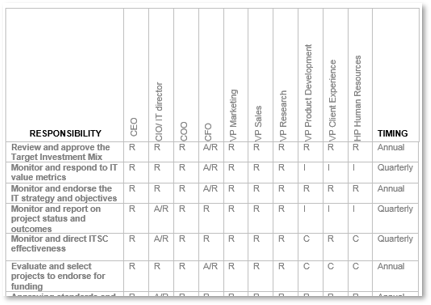
Define IT steering committee participant RACI for each of the responsibilities
1.7
- Use the table provided in the IT Steering Committee Charter and edit he list of responsibilities to reflect the chosen responsibilities of your ITSC.
- Along the top of the chart list the participant names, and in the right hand column of the table document the agreed upon timing from the previous exercise.
- For each of the responsibilities identify whether participants are Responsible, Accountable, Consulted, or Informed by denoting an R, A, C, I, or N/A in the table. Use N/A if this is a responsibility that the participant has no involvement in.
- Review your finalized RACI chart. If there are participants who are only consulted or informed about the majority of responsibilities, consider removing them from the IT steering committee. You only want the decision makers on the committee.
INPUT
- Responsibilities
- Participants
OUTPUT
- RACI documented in the ITSC Charter
Materials
- ITSC RACI template
- Projector
Participants
- IT leadership
Building the agenda may seem trivial, but it is key for running effective meetings
49% of people consider unfocused meetings as the biggest workplace time waster.*
63% of the time meetings do not have prepared agendas.*
80% Reduction of time spent in meetings by following a detailed agenda and starting on time.*
*(Source: http://visual.ly/fail-plan-plan-fail).
EFFECTIVE MEETING AGENDAS:
- Have clearly defined meeting objectives.
- Effectively time-boxed based on priority items.
- Defined at least two weeks prior to the meetings.
- Evaluated regularly – are not static.
- Leave time at the end for new business, thus minimizing interruptions.
BUILDING A CONSENT AGENDA
A consent agenda is a tool to free up time at meetings by combining previously discussed or simple items into a single item. Items that can be added to the consent agenda are those that are routine, noncontroversial, or provided for information’s sake only. It is expected that participants read this information and, if it is not pulled out, that they are in agreement with the details.
Members have the option to pull items out of the consent agenda for discussion if they have questions. Otherwise these are given no time on the agenda.
Define the IT steering committee meeting agendas and procedures
1.8
Agendas
- Review the listed responsibilities, participants, and timing as identified in a previous exercise.
- Annual meeting: Identify if all of the responsibilities will be included in the annual meeting agenda (likely all governance responsibilities).
- Quarterly Meeting Agenda: Remove the meeting responsibilities from the annual meeting agenda that are not required and create a list of responsibilities for the quarterly meetings.
- Monthly Meeting Agenda: Remove all responsibilities from the list that are only annual or quarterly and compile a list of monthly meeting responsibilities.
- Review each responsibility, and estimate the amount of time each task will take within the meeting. We recommend giving yourself at least an extra 10-20% more time for each agenda item for your first meeting. It’s better to have more time than to run out.
- Complete the Agenda Template in the IT Steering Committee Charter.
Procedures:
- Review the list of IT steering committee procedures, and replace the grey text with the information appropriate for your organization.
INPUT
- Responsibility cadence
OUTPUT
- ITSC annual, quarterly, monthly meeting agendas & procedures
Materials
- ITSC Charter
Participants
- IT leadership team
Draft your IT steering committee purpose statement and goals
1.9
- In a meeting with your IT leadership team – and considering the defined responsibilities, participants, and opportunities and threats identified – review the example goal statement in the IT Steering Committee Charter, and first identify whether any of these statements apply to your organization. Select the statements that apply and collaboratively make any changes needed.
- Define unique goal statements by considering the following questions:
- What three things would you realistically list for the ITSC to achieve.
- If you were to accomplish three things in the next year, what would those be?
- Document those goals in the IT Steering Committee Charter.
- With those goal statements in mind, consider the overall purpose of the committee. The purpose statement should be a reflection of what the committee does, why it does it, and the goals.
- Have each individual review the example purpose statement, and draft what they think a good purpose statement would be.
- Present each statement, and work together to determine a best of breed statement.
- Document this in the IT Steering Committee Charter.
INPUT
- Responsibilities, participants, top 10 lists of challenges and opportunities.
OUTPUT
- ITSC goals and purpose statement
Materials
- ITSC Charter
Participants
- IT leadership team
CASE STUDY
"Clearly defined Committee Charter allows CIO to escape the bad reputation of previous committee."
Industry: Consumer Goods
Source: Interview
CHALLENGE
The new CIO at a large consumer goods company had difficulty generating interest in creating a new IT steering committee. The previous CIO had created a steering committee that was poorly organized and did not involve all of the pertinent members. This led to a committee focused on politics that would often devolve into gossip. Also, many members were dissatisfied with the irregular meetings that would often go over their allotted time.
In order to create a new committee, the new CIO needed to dispel the misgivings of the business leadership.
SOLUTION
The new CIO decided to build the new steering committee from the ground up in a systematic way.
She collected information from relevant stakeholders about what they know/how they feel about IT and used this information to build a detailed charter.
Using this info she outlined the new steering committee charter and included in it the:
- Purpose
- Responsibilities
- RACI Chart
- Procedures
OUTCOME
The new steering committee included all the key members of business units, and each member was clear on their roles in the meetings. Meetings were streamlined and effective. The adjustments in the charter and the improvement in meeting quality played a role in improving the satisfaction scores of business leaders with IT by 21%.
If you want additional support, have our analysts guide you through this phase as part of an Info-Tech workshop
Book a workshop with our Info-Tech analysts:

- To accelerate this project, engage your IT team in an Info-Tech workshop with an Info-Tech analyst team.
- Info-Tech analysts will join you and your team onsite at your location or welcome you to Info-Tech’s historic Toronto office to participate in an innovative onsite workshop.
- Contact your account manager (www.infotech.com/account), or email Workshops@InfoTech.com for more information.
The following are sample activities that will be conducted by Info-Tech analysts with your team:
1.1
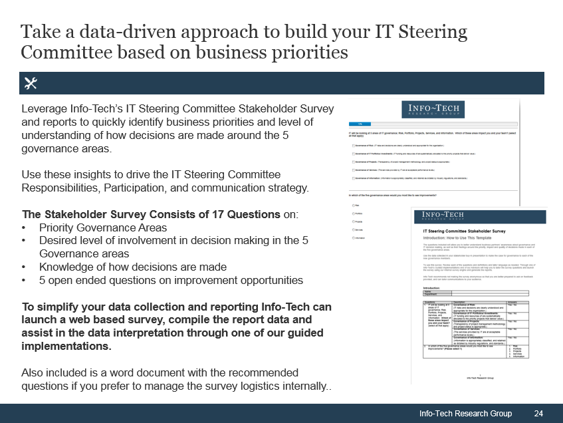
Survey your ITSC stakeholders
Prior to the workshop, Info-Tech’s advisors will work with you to launch the IT Steering Committee Stakeholder Survey to understand business priorities and level of understanding of how decisions are made. Using this data, we will create the IT steering committee responsibilities, participation, and communication strategy.
1.7
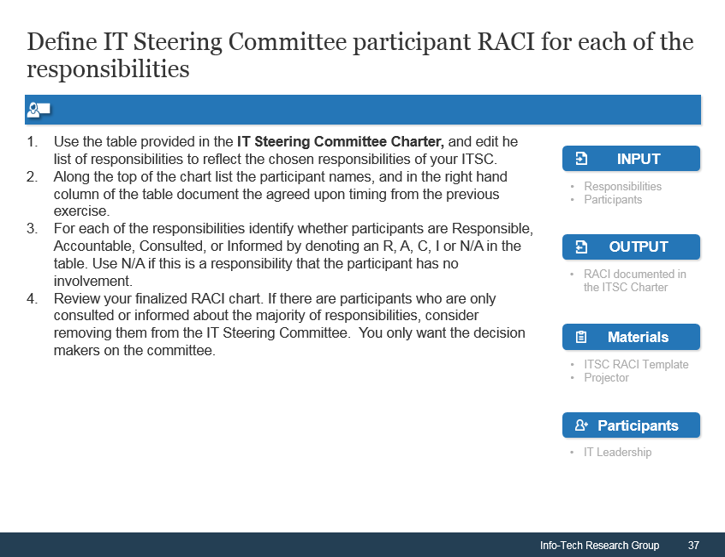
Define a participant RACI for each of the responsibilities
The analyst will facilitate several exercises to help you and your stakeholders create an authority matrix. The output will be defined responsibilities and authorities for members.
Phase 2
Build the IT Steering Committee Process
Phase 2 outline
Call 1-888-670-8889 or email GuidedImplementations@InfoTech.com for more information.
Complete these steps on your own, or call us to complete a guided implementation. A guided implementation is a series of 2-3 advisory calls that help you execute each phase of a project. They are included in most advisory memberships.
| Guided Implementation 2: Define your ITSC Processes Proposed Time to Completion: 2 weeks |
|---|
Review SIPOCs and Process Creation Start with an analyst kick-off call:
Then complete these activities…
With these tools & templates: Phase 2 of the Establish an Effective IT Steering Committee blueprint | Finalize the SIPOC Review Draft SIPOC:
Then complete these activities…
With these tools & templates: Phase 2 of the Establish an Effective IT Steering Committee blueprint | Finalize Metrics Finalize phase deliverable:
Then complete these activities…
With these tools & templates: Phase 2 of the Establish an Effective IT Steering Committee blueprint |
Build the IT Steering Committee Process
This step will walk you through the following activities:
- Define high-level steering committee processes using SIPOC
- Select steering committee metrics
This step involves the following participants:
- CIO
- IT Steering Committee
- IT Leadership Team
- PMO
Key Insight:
Building high-level IT steering committee processes brings your committee to life. Having a clear process will ensure that you have the right information from the right sources so that committees can operate and deliver the appropriate output to the customers who need it.
Build your high-level IT steering committee processes to enable committee functionality
The IT steering committee is only valuable if members are able to successfully execute on responsibilities.
One of the most common mistakes organizations make is that they build their committee charters and launch into their first meeting. Without defined inputs and outputs, a committee does not have the needed information to be able to effectively execute on responsibilities and is unable to meet its stated goals.
The arrows in this picture represent the flow of information between the IT steering committee, other committees, and IT management.
Building high-level processes will define how that information flows within and between committees and will enable more rapid decision making. Participants will have the information they need to be confident in their decisions.
| Strategic | IT Steering Committee | |
| Tactical | Project Governance Service Governance Risk Governance Information Governance |
IT Management |
| Operational | Risk Task Force |
Define the high-level process for each of the IT steering committee responsibilities
Info-Tech recommends using SIPOC as a way of defining how the IT steering committee will operate.
Derived from the core methodologies of Six Sigma process management, SIPOC – a model of Suppliers, Inputs, Processes, Outputs, Customers – is one of several tools that organizations can use to build high level processes. SIPOC is especially effective when determining process scope and boundaries and to gain consensus on a process.
By doing so you’ll ensure that:
- Information and documentation required to complete each responsibility is identified.
- That the results of committee meetings are distributed to those customers who need the information.
- Inputs and outputs are identified and that there is defined accountability for providing these.
Remember: Your IT steering committee is not a working committee. Enable effective decision making by ensuring participants have the necessary information and appropriate recommendations from key stakeholders to make decisions.
| Supplier | Input |
| Who provides the inputs to the governance responsibility. | The documented information, data, or policy required to effectively respond to the responsibility. |
| Process | |
| In this case this represents the IT steering committee responsibility defined in terms of the activity the ITSC is performing. | |
| Output | Customer |
| The outcome of the meeting: can be approval, rejection, recommendation, request for additional information, endorsement, etc. | Receiver of the outputs from the committee responsibility. |
Define your SIPOC model for each of the IT steering committee responsibilities
2.1
- In a meeting with your IT leadership, draw the SIPOC model on a whiteboard or flip-chart paper. Either review the examples on the following slides or start from scratch.
- If you are adjusting the following slides, consider the templates you already have which would be appropriate inputs and make adjustments as needed.
For atypical responsibilities:
- Start with the governance responsibility and identify what specifically it is that the IT steering committee is doing with regards to that responsibility. Write that in the center of the model.
- As a group, consider what information or documentation would be required by the participants to effectively execute on the responsibility.
- Identify which individual will supply each piece of documentation. This person will be accountable for this moving forward.
- Outputs: Once the committee has met about the responsibility, what information or documentation will be produced. List all of those documents.
- Identify the individuals who need to receive the outputs of the information.
- Repeat this for all of the responsibilities.
- Once complete, document the SIPOC models in the IT Steering Committee Charter.
INPUT
- List of responsibilities
- Example SIPOCs
OUTPUT
- SIPOC model for all responsibilities.
Materials
- Whiteboard
- Markers
- ITSC Charter
Participants
- IT leadership team
SIPOC examples for typical ITSC responsibilities
| SIPOC: Establish the target investment mix | |
| Supplier | Input |
| CIO |
|
| Process | |
| Responsibility: The IT steering committee shall review and approve the target investment mix. | |
| Output | Customer |
|
|
| SIPOC: Endorse the IT budget | |
| Supplier | Input |
| CIO |
See Info-Tech’s blueprint IT Budget Presentation |
| Process | |
Responsibility: Review the proposed IT budget as defined by the CIO and CFO. |
|
| Output | Customer |
|
|
SIPOC examples for typical ITSC responsibilities
| SIPOC: Monitor IT value metrics | |
| Supplier | Input |
| CIO |
|
| Process | |
Responsibility: Review recommendations and either accept or reject recommendations. Refine go-forward metrics. |
|
| Output | Customer |
|
|
| SIPOC: Evaluate and select programs/projects to fund | |
| Supplier | Input |
| PMO |
See Info-Tech’s blueprint Grow Your Own PPM Solution |
| Process | |
Responsibility: The ITSC will approve the list of projects to fund based on defined prioritization criteria – in line with capacity and IT budget. It is also responsible for identifying the prioritization criteria in line with organizational priorities. |
|
| Output | Customer |
|
|
SIPOC examples for typical ITSC responsibilities
| SIPOC: Endorse the IT strategy | |
| Supplier | Input |
| CIO |
See Info-Tech’s blueprint IT Strategy and Roadmap |
| Process | |
Responsibility: Review, understand, and endorse the IT strategy. | |
| Output | Customer |
|
|
| SIPOC: Monitor project management metrics | |
| Supplier | Input |
| PMO |
|
| Process | |
Responsibility: Review recommendations around PM metrics and define target metrics. Endorse current effectiveness levels or determine corrective action. |
|
| Output | Customer |
|
|
SIPOC examples for typical ITSC responsibilities
| SIPOC: Approve launch of planned and unplanned project | |
| Supplier | Input |
| CIO |
See Info-Tech’s Blueprint: Grow Your Own PPM Solution |
| Process | |
Responsibility: Review the list of projects and approve the launch or reprioritization of projects. | |
| Output | Customer |
|
|
| SIPOC: Monitor stakeholder satisfaction with services and other service metrics | |
| Supplier | Input |
| Service Manager |
|
| Process | |
Responsibility: Review recommendations around service metrics and define target metrics. Endorse current effectiveness levels or determine corrective action. |
|
| Output | Customer |
|
|
SIPOC examples for typical ITSC responsibilities
| SIPOC: Approve plans for new or changed service requirements | |
| Supplier | Input |
| Service Manager |
|
| Process | |
Responsibility: Review IT recommendations, approve changes, and communicate those to staff. |
|
| Output | Customer |
|
|
| SIPOC: Monitor risk management metrics | |
| Supplier | Input |
| CIO |
|
| Process | |
Responsibility: Review recommendations around risk metrics and define target metrics. Endorse current effectiveness levels or determine corrective action. |
|
| Output | Customer |
|
|
SIPOC examples for typical ITSC responsibilities
| SIPOC: Review the prioritized list of risks | |
| Supplier | Input |
| Risk Manager |
|
| Process | |
Responsibility: Accept the risk registrar and define any additional action required. | |
| Output | Customer |
|
|
| SIPOC: Define information lifecycle process ownership | |
| Supplier | Input |
| CIO |
|
| Process | |
Responsibility: Define responsibility and accountability for information lifecycle ownership. |
|
| Output | Customer |
|
|
SIPOC examples for typical ITSC responsibilities
| SIPOC: Monitor information lifecycle metrics | |
| Supplier | Input |
| Information lifecycle owner |
|
| Process | |
Responsibility: Review recommendations around information management metrics and define target metrics. Endorse current effectiveness levels or determine corrective action. |
|
| Output | Customer |
|
|
Define which metrics you will report to the IT steering committee
2.2
- Consider your IT steering committee goals and the five IT governance areas.
- For each governance area, identify which metrics you are currently tracking and determine whether these metrics are valuable to IT, to the business, or both. For metrics that are valuable to business stakeholders determine whether you have an identified target metric.
New Metrics:
- For each of the five IT governance areas review your SWOT analysis and document your key opportunities and weaknesses.
- For each, brainstorm hypotheses around why the opportunity was weak or was a success. For each hypothesis identify if there are any clear ways to measure and test the hypothesis.
- Review the list of metrics and select 5-7 metrics to track for each prioritized governance area.
INPUT
- List of responsibilities
- Example SIPOCs
OUTPUT
- SIPOC model for all responsibilities
Materials
- Whiteboard
- Markers
Participants
- IT leadership team
IT steering committee metric triggers to consider
RISK
- Risk profile % increase
- # of actionable risks outstanding
- # of issues arising not identified prior
- # of security breaches
SERVICE
- Number of business disruptions due to IT service incidents
- Number of service requests by department
- Number of service requests that are actually projects
- Causes of tickets overall and by department
- Percentage of duration attributed to waiting for client response
PROJECTS
- Projects completed within budget
- Percentage of projects delivered on time
- Project completion rate
- IT completed assigned portion to scope
- Project status and trend dashboard
INFORMATION / DATA
- % of data properly classified
- # of incidents locating data
- # of report requests by complexity
- # of open data sets
PPM /INVESTMENTS
- CIO Business Vision (an Info-Tech diagnostic survey that helps align IT strategy with business goals)
- Level of stakeholder satisfaction and perceived value
- Percentage of ON vs. OFF cycle projects by area/silo
- Realized benefit to business units based on investment mix
- Percent of enterprise strategic goals and requirements supported by strategic goals
- Target vs. actual budget
- Reasons for off-cycle projects causing delays to planned projects
CASE STUDY
Industry: Consumer Goods
Source: Interview
"IT steering committee’s reputation greatly improved by clearly defining its process."
CHALLENGE
One of the major failings of the previous steering committee was its poorly drafted procedures. Members of the committee were unclear on the overall process and the meeting schedule was not well established.
This led to low attendance at the meetings and ineffective meetings overall. Since the meeting procedures weren’t well understood, some members of the leadership team took advantage of this to get their projects pushed through.
SOLUTION
The first step the new CIO took was to clearly outline the meeting procedures in her new steering committee charter. The meeting agenda, meeting goals, length of time, and outcomes were outlined, and the stakeholders signed off on their participation.
She also gave the participants a SIPOC, which helped members who were unfamiliar with the process a high-level overview. It also reacquainted previous members with the process and outlined changes to the previous, out-of-date processes.
OUTCOME
The participation rate in the committee meetings improved from the previous rate of approximately 40% to 90%. The committee members were much more satisfied with the new process and felt like their contributions were appreciated more than before.
If you want additional support, have our analysts guide you through this phase as part of an Info-Tech workshop
Book a workshop with our Info-Tech analysts:

- To accelerate this project, engage your IT team in an Info-Tech workshop with an Info-Tech analyst team.
- Info-Tech analysts will join you and your team onsite at your location or welcome you to Info-Tech’s historic Toronto office to participate in an innovative onsite workshop.
- Contact your account manager (www.infotech.com/account), or email Workshops@InfoTech.com for more information.
The following are sample activities that will be conducted by Info-Tech analysts with your team:
2.1
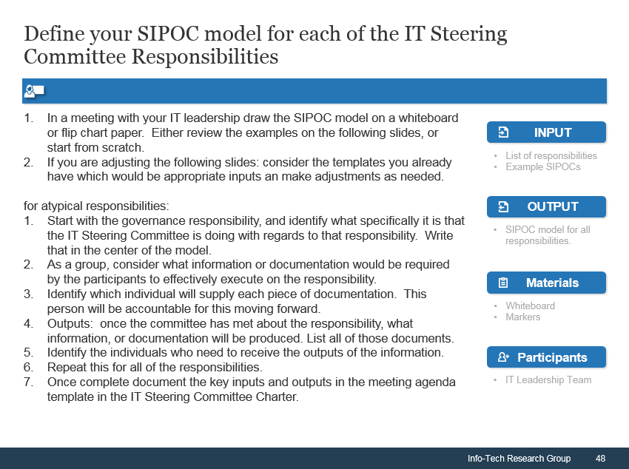
Define a SIPOC for each of the ITSC responsibilities
Create SIPOCs for each of the governance responsibilities with the help of an Info-Tech advisor.
2.2
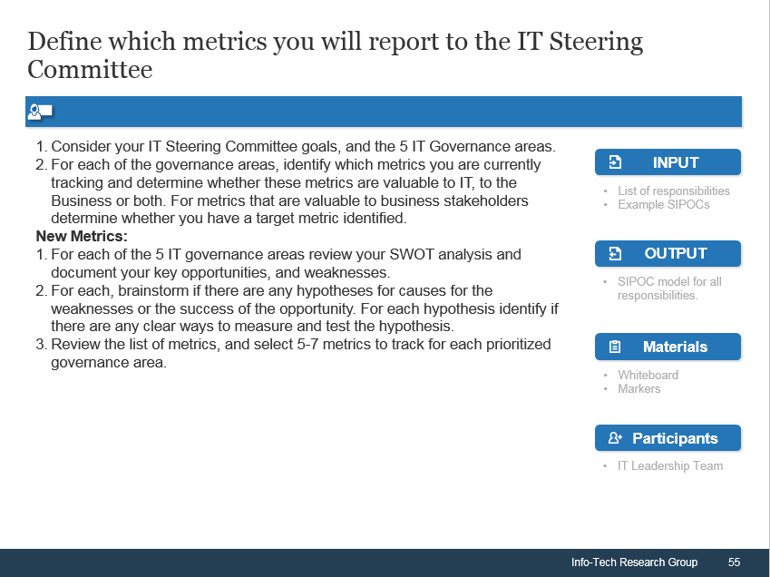
Establish the reporting metrics for the ITSC
The analyst will facilitate several exercises to help you and your stakeholders define the reporting metrics for the ITSC.
Phase 3
Build the Stakeholder Presentation
Phase 3 outline
Call 1-888-670-8889 or email GuidedImplementations@InfoTech.com for more information.
Complete these steps on your own, or call us to complete a guided implementation. A guided implementation is a series of 2-3 advisory calls that help you execute each phase of a project. They are included in most advisory memberships.
| Guided Implementation 3: Build the Stakeholder Presentation Proposed Time to Completion: 1 week |
|---|
Customize the Presentation Start with an analyst kick-off call:
Then complete these activities…
With these tools & templates: IT Steering Committee Stakeholder Presentation
| Review and Practice the Presentation Review findings with analyst:
Then complete these activities…
With these tools & templates:
| Review the First ITSC Meeting Finalize phase deliverable:
Then complete these activities…
With these tools & templates: Establish an Effective IT Steering Committee blueprint |
Build the Stakeholder Presentation
This step will walk you through the following activities:
- Organizing the first ITSC meeting
- Customizing an ITSC stakeholder presentation
- Determine ITSC responsibilities and participants
- Determine ITSC procedures
This step involves the following participants:
- CIO
- IT Steering Committee
- IT Leadership Team
- PMO
Key Insight:
Stakeholder engagement will be critical to your ITSC success, don't just focus on what is changing. Ensure stakeholders know why you are engaging them and how it will help them in their role.
Hold a kick-off meeting with your IT steering committee members to explain the process, responsibilities, and goals
3.1
Don’t take on too much in your first IT steering committee meeting. Many participants may not have participated in an IT steering committee before, or some may have had poor experiences in the past.
Use this meeting to explain the role of the IT steering committee and why you are implementing one, and help participants to understand their role in the process.
Quickly customize Info-Tech’s IT Steering Committee Stakeholder Presentation template to explain the goals and benefits of the IT steering committee, and use your own data to make the case for governance.
At the end of the meeting, ask committee members to sign the committee charter to signify their agreement to participate in the IT steering committee.
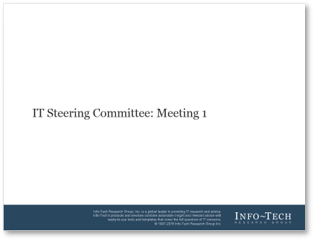
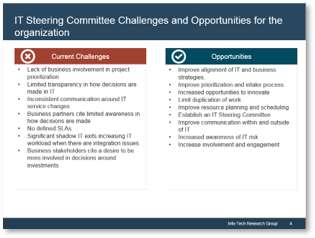
Tailor the IT Steering Committee Stakeholder Presentation template: slides 1-5
3.2 Estimated Time: 10 minutes
Review the IT Steering Committee Stakeholder Presentation template. This document should be presented at the first IT steering committee meeting by the assigned Committee Chair.
Customization Options
Overall: Decide if you would like to change the presentation template. You can change the color scheme easily by copying the slides in the presentation deck and pasting them into your company’s standard template. Once you’ve pasted them in, scan through the slides and make any additional changes needed to formatting.
Slide 2-3: Review the text on each of the slides and see if any wording should be changed to better suite your organization.
Slide 4: Review your list of the top 10 challenges and opportunities as defined in section 2 of this blueprint. Document those in the appropriate sections. (Note: be careful that the language is business-facing; challenges and opportunities should be professionally worded.)
Slide 5: Review the language on slide 5 to make any necessary changes to suite your organization. Changes here should be minimal.
INPUT
- Top 10 list
- Survey report
- ITSC Charter
OUTPUT
- Ready-to-present presentation for defined stakeholders
Materials
- IT Steering Committee Stakeholder Presentation
Participants
- IT Steering Committee Chair/CIO
Tailor the IT Steering Committee Stakeholder Presentation template: slides 6-10
3.2 Estimated Time: 10 minutes
Customization Options
Slide 6: The goal of this slide is to document and share the names of the participants on the IT steering committee. Document the names in the right-hand side based on your IT Steering Committee Charter.
Slides 7-9:
- Review the agenda items as listed in your IT Steering Committee Charter. Document the annual, quarterly, and monthly meeting responsibilities on the left-hand side of slides 7-9.
- Meeting Participants: For each slide, list the members who are required for that meeting.
- Document the key required reading materials as identified in the SIPOC charts under “inputs.”
- Document the key meeting outcomes as identified in the SIPOC chart under “outputs.”
Slide 10: Review and understand the rollout timeline. Make any changes needed to the timeline.
INPUT
- Top 10 list
- Survey report
- ITSC Charter
OUTPUT
- Ready-to-present presentation for defined stakeholders
Materials
- IT Steering Committee Stakeholder Presentation
Participants
- IT Steering Committee Chair/CIO
Present the information to the IT leadership team to increase your comfort with the material
3.3 Estimated Time: 1-2 hours
- Once you have finished customizing the IT Steering Committee Stakeholder Presentation, practice presenting the material by meeting with your IT leadership team. This will help you become more comfortable with the dialog and anticipate any questions that might arise.
- The ITSC chair will present the meeting deck, and all parties should discuss what they think went well and opportunities for improvement.
- Each business relationship manager should document the needed changes in preparation for their first meeting.
INPUT
- IT Steering Committee Stakeholder Presentation - Meeting 1
Participants
- IT leadership team
Schedule your first meeting of the IT steering committee
3.4
By this point, you should have customized the meeting presentation deck and be ready to meet with your IT steering committee participants.
The meeting should be one hour in duration and completed in person.
Before holding the meeting, identify who you think is going to be most supportive and who will be least. Consider meeting with those individuals independently prior to the group meeting to elicit support or minimize negative impacts on the meeting.
Customize this calendar invite script to invite business partners to participate in the meeting.
Hello [Name],
As you may have heard, we recently went through an exercise to develop an IT steering committee. I’d like to take some time to discuss the results of this work with you, and discuss ways in which we can work together in the future to better enable corporate goals.
The goals of the meeting are:
- Discuss the benefits of an IT steering committee
- Review the results of the organizational survey
- Introduce you to our new IT steering committee
I look forward to starting this discussion with you and working with you more closely in the future.
Warm regards,
CASE STUDY
Industry:Consumer Goods
Source: Interview
"CIO gains buy-in from the company by presenting the new committee to its stakeholders."
CHALLENGE
Communication was one of the biggest steering committee challenges that the new CIO inherited.
Members were resistant to joining/rejoining the committee because of its previous failures. When the new CIO was building the steering committee, she surveyed the members on their knowledge of IT as well as what they felt their role in the committee entailed.
She found that member understanding was lacking and that their knowledge surrounding their roles was very inconsistent.
SOLUTION
The CIO dedicated their first steering committee meeting to presenting the results of that survey to align member knowledge.
She outlined the new charter and discussed the roles of each member, the goals of the committee, and the overarching process.
OUTCOME
Members of the new committee were now aligned in terms of the steering committee’s goals. Taking time to thoroughly outline the procedures during the first meeting led to much higher member engagement. It also built accountability within the committee since all members were present and all members had the same level of knowledge surrounding the roles of the ITSC.
If you want additional support, have our analysts guide you through this phase as part of an Info-Tech workshop
Book a workshop with our Info-Tech analysts:

- To accelerate this project, engage your IT team in an Info-Tech workshop with an Info-Tech analyst team.
- Info-Tech analysts will join you and your team onsite at your location or welcome you to Info-Tech’s historic Toronto office to participate in an innovative onsite workshop.
- Contact your account manager (www.infotech.com/account), or email Workshops@InfoTech.com for more information.
The following are sample activities that will be conducted by Info-Tech analysts with your team:
3.1
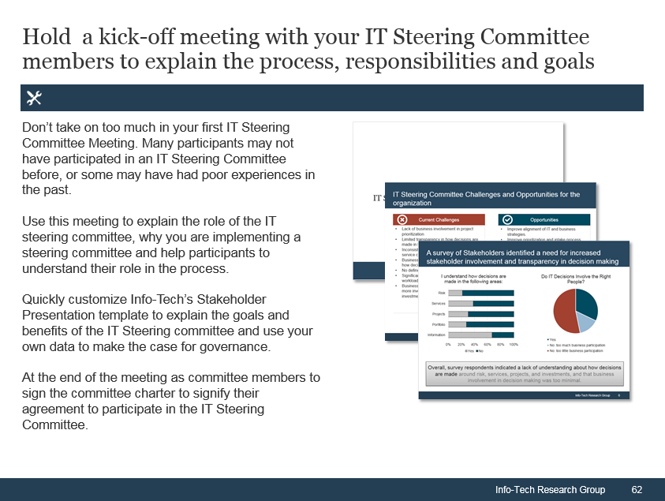
Create a presentation for ITSC stakeholders to be presented at the first ITSC meeting
Work with an Info-Tech advisor to customize our IT Steering Committee Stakeholder Presentation template. Use this presentation to gain stakeholder buy-in by making the case for an ITSC.
Phase 4
Define the Prioritization Criteria
Phase 4 outline
Call 1-888-670-8889 or email GuidedImplementations@InfoTech.com for more information.
Complete these steps on your own, or call us to complete a guided implementation. A guided implementation is a series of 2-3 advisory calls that help you execute each phase of a project. They are included in most advisory memberships.
| Guided Implementation : Define the Prioritization Criteria Proposed Time to Completion: 4 weeks |
|---|
| Discuss Prioritization Criteria Start with an analyst kick-off call:
Then complete these activities...
With these tools & templates: IT Steering Committee Project Prioritization Tool | Customize the IT Steering Committee Project Prioritization Tool Review findings with analyst:
Then complete these activities…
With these tools & templates: IT Steering Committee Project Prioritization Tool | Review Results of the Pilot Test Finalize phase deliverable:
Then complete these activities…
With these tools & templates: IT Steering Committee Project Prioritization Tool |
Define the Project Prioritization Criteria
This step will walk you through the following activities:
- Selecting the appropriate project prioritization criteria for your organization
- Developing weightings for the prioritization criteria
- Filling in Info-Tech’s IT Steering Committee Project Prioritization Tool
This step involves the following participants:
- CIO
- IT Steering Committee
- IT Leadership Team
- PMO
Key Insight:
The steering committee sets and agrees to principles that guide prioritization decisions. The agreed upon principles will affect business unit expectations and justify the deferral of requests that are low priority. In some cases, we have seen the number of requests drop substantially because business units are reluctant to propose initiatives that do not fit high prioritization criteria.
Understand the role of the IT steering committee in project prioritization
One of the key roles of the IT steering committee is to review and prioritize the portfolio of IT projects.
What is the prioritization based on? Info-Tech recommends selecting four broad criteria with two dimensions under each to evaluate the value of the projects. The criteria are aligned with how the project generates value for the organization and the execution of the project.
What is the role of the steering committee in prioritizing projects? The steering committee is responsible for reviewing project criteria scores and making decisions about where projects rank on the priority list. Planning, resourcing, and project management are the responsibility of the PMO or the project owner.
| Info-Tech’s Sample Criteria |
|---|
| Value Strategic Alignment: How much a project supports the strategic goals of the organization. Customer Satisfaction: The impact of the project on customers and how visible a project will be with customers. Operational Alignment: Whether the project will address operational issues or compliance. |
| Execution Financial: Predicted ROI and cost containment strategies. Risk: Involved with not completing projects and strategies to mitigate it. Feasibility: How easy the project is to complete and whether staffing resources exist. |
Use Info-Tech’s IT Steering Committee Project Prioritization Tool to catalog and prioritize your project portfolio
4.1
- Use Info-Tech’s IT Steering Committee Project Prioritization Tool in conjunction with the following activities to catalog and prioritize all of the current IT projects in your portfolio.
- Assign weightings to your selected criteria to prioritize projects based on objective scores assigned during the intake process and adjust these weightings on an annual basis to align with changing organizational priorities and goals.
- Use this tool at steering committee meetings to streamline the prioritization process and create alignment with the PMO and project managers.
- Monitor ongoing project status and build a communication channel between the PMO and project managers and the IT steering committee.
- Adjusting the titles in the Settings tab will automatically adjust the titles in the Project Data tab.
- Note: To customize titles in the document you must unprotect the content under the View tab. Be sure to change the content back to protected after making the changes.
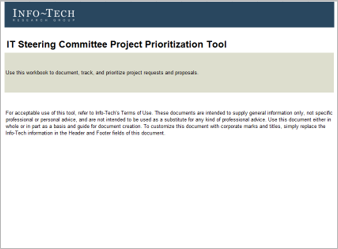
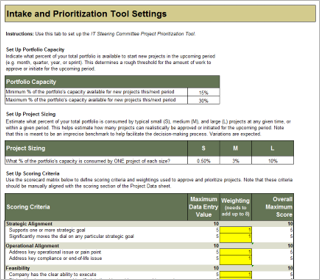
Establish project prioritization criteria and build the matrix
4.2 Estimated Time: 1 hour
- During the second steering committee meeting, discuss the criteria you will be basing your project prioritization scoring on.
- Review Info-Tech’s prioritization criteria matrix, located in the Prioritization Criteria List tab of the IT Steering Committee Project Prioritization Tool, to gain ideas for what criteria would best suit your organization.
- Write these main criteria on the whiteboard and brainstorm criteria that are more specific for your organization; include these on the list as well.
- Discuss the criteria. Eliminate criteria that won’t contribute strongly to the prioritization process and vote on the remaining. Select four main criteria from the list.
- After selecting the four main criteria, write these on the whiteboard and brainstorm the dimensions that fall under the criteria. These should be more specific/measurable aspects of the criteria. These will be the statements that values are assigned to for prioritizing projects so they should be clear. Use the Prioritization Criteria List in the tool to help generate ideas.
- After creating the dimensions, determine what the scoring statements will be. These are the statements that will be used to determine the score out of 10 that the different dimensions will receive.
- Adjust the Settings and Project Data tabs in the IT Steering Committee Project Prioritization Tool to reflect your selections.
- Edit Info-Tech’s IT Project Intake Form or the intake form that you currently use to contain these criteria and scoring parameters.
INPUT
- Group input
- IT Steering Committee Project Prioritization Tool
OUTPUT
- Project prioritization criteria to be used for current and future projects
Materials
- Whiteboard and markers
Participants
- IT steering committee
- CIO
- IT leadership
Adjust prioritization criteria weightings to reflect organizational needs
4.3 Estimated Time: 1 hour
- In the second steering committee meeting, after deciding what the project prioritization criteria will be, you need to determine how much weight (the importance) each criteria will receive.
- Use the four agreed upon criteria with two dimensions each, determined in the previous activity.
- Perform a $100 test to assign proportions to each of the criteria dimensions.
- Divide the committee into pairs.
- Tell each pair that they have $100 divide among the 4 major criteria based on how important they feel the criteria is.
- After dividing the initial $100, ask them to divide the amount they allocated to each criteria into the two sub-dimensions.
- Next, ask them to present their reasoning for the allocations to the rest of the committee.
- Discuss the weighting allotments and vote on the best one (or combination).
- Input the weightings in the Settings tab of the IT Steering Committee Project Prioritization Tool and document the discussion.
- After customizing the chart establish the owner of the document. This person should be a member of the PMO or the most suitable IT leader if a PMO doesn’t exist.
- Only perform this adjustment annually or if a major strategic change happens within the organization.
INPUT
- Group discussion
OUTPUT
- Agreed upon criteria weighting
- Complete prioritization tool
Materials
- IT Steering Committee Project Prioritization Tool
- Whiteboard and sticky notes
Participants
- IT steering committee
- IT leadership
Document the prioritization criteria weightings in Info-Tech’s IT Steering Committee Project Prioritization Tool.
Configure the prioritization tool to align your portfolio with business strategy
4.4 Estimated Time: 60 minutes
Download Info-Tech’s Project Intake and Prioritization Tool.

Rank: Project ranking will dynamically update relative to your portfolio capacity (established in Settings tab) and the Size, Scoring Progress, Remove from Ranking, and Overall Score columns. The projects in green represent top priorities based on these inputs, while yellow projects warrant additional consideration should capacity permit.
Scoring Progress: You will be able to determine some items on the scorecard earlier in the scoring progress (such as strategic and operational alignment). As you fill in scoring columns on the Project Data tab, the Scoring Progress column will dynamically update to track progress.
The Overall Score will update automatically as you complete the scoring columns (refer to Activity 4.2).
Days in Backlog: This column will help with backlog management, automatically tracking the number of days since an item was added to the list based on day added and current date.
Validate your new prioritization criteria using previous projects
4.5 Estimated Time: 2 hours
- After deciding on the prioritization criteria, you need to test their validity.
- Look at the portfolio of projects that were completed in the previous year.
- Go through each project and score it according to the criteria that were determined in the previous exercise.
- Enter the scores and appropriate weighting (according to goals/strategy of the previous year) into the IT Steering Committee Project Prioritization Tool.
- Look at the prioritization given to the projects in reference to how they were previously prioritized.
- Adjust the criteria and weighting to either align the new prioritization criteria with previous criteria or to align with desired outcomes.
- After scoring the old projects, pilot test the tool with upcoming projects.
INPUT
- Information on previous year’s projects
- Group discussion
OUTPUT
- Pilot tested project prioritization criteria
Materials
- IT Steering Committee Project Prioritization Tool
Participants
- IT steering committee
- IT leadership
- PMO
Pilot the scorecard to validate criteria and weightings
4.6 Estimated Time: 60 minutes
- Pilot your criteria and weightings in the IT Steering Committee Project Prioritization Tool using project data from one or two projects currently going through approval process.
- For most projects, you will be able to determine strategic and operational alignment early in the scoring process, while the feasibility and financial requirements will come later during business case development. Score each column as you can. The tool will automatically track your progress in the Scoring Progress column on the Project Data tab.
Projects that are scored but not prioritized will populate the portfolio backlog. Items in the backlog will need to be rescored periodically, as circumstances can change, impacting scores. Factors necessitating rescoring can include:
- Assumptions in business case have changed.
- Organizational change – e.g. a new CEO or a change in strategic objectives.
- Major emergencies or disruptions – e.g. a security breach.
Score projects using the Project Data tab in Info-Tech’s IT Steering Committee Project Prioritization Tool
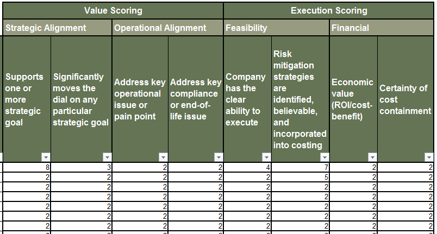 IT Steering Committee Project Prioritization Tool is depicted. The Data Tab is shown.">
IT Steering Committee Project Prioritization Tool is depicted. The Data Tab is shown.">
Use Info-Tech’s IT Project Intake Form to streamline the project prioritization and approval process
4.7
- Use Info-Tech’s IT Project Intake Form template to streamline the project intake and prioritization process.
- Customize the chart on page 2 to include the prioritization criteria that were selected during this phase of the blueprint.
- Including the prioritization criteria at the project intake phase will free up a lot of time for the steering committee. It will be their job to verify that the criteria scores are accurate.
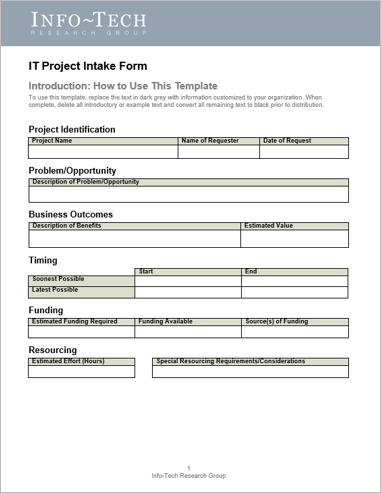
After prioritizing and selecting your projects, determine how they will be resourced
Consult these Info-Tech blueprints on project portfolio management to create effective portfolio project management resourcing processes.
 Create Project Management Success
Create Project Management Success
 Develop a Project Portfolio Management Strategy
Develop a Project Portfolio Management Strategy
CASE STUDY
Industry: Consumer Goods
Source: Interview
"Clear project intake and prioritization criteria allow for the new committee to make objective priority decisions."
CHALLENGE
One of the biggest problems that the previous steering committee at the company had was that their project intake and prioritization process was not consistent. Projects were being prioritized based on politics and managers taking advantage of the system.
The procedure was not formalized so there were no objective criteria on which to weigh the value of proposed projects. In addition to poor meeting attendance, this led to the overall process being very inconsistent.
SOLUTION
The new CIO, with consultation from the newly formed committee, drafted a set of criteria that focused on the value and execution of their project portfolio. These criteria were included on their intake forms to streamline the rating process.
All of the project scores are now reviewed by the steering committee, and they are able to facilitate the prioritization process more easily.
The objective criteria process also helped to prevent managers from taking advantage of the prioritization process to push self-serving projects through.
OUTCOME
This was seen as a contributor to the increase in satisfaction scores for IT, which improved by 12% overall.
The new streamlined process helped to reduce capacity constraints on IT, and it alerted the company to the need for more IT employees to help reduce these constraints further. The IT department was given permission to hire two new additional staff members.
If you want additional support, have our analysts guide you through this phase as part of an Info-Tech workshop
Book a workshop with our Info-Tech analysts:

- To accelerate this project, engage your IT team in an Info-Tech workshop with an Info-Tech analyst team.
- Info-Tech analysts will join you and your team onsite at your location or welcome you to Info-Tech’s historic Toronto office to participate in an innovative onsite workshop.
- Contact your account manager (www.infotech.com/account), or email Workshops@InfoTech.com for more information.
The following are sample activities that will be conducted by Info-Tech analysts with your team:
4.1
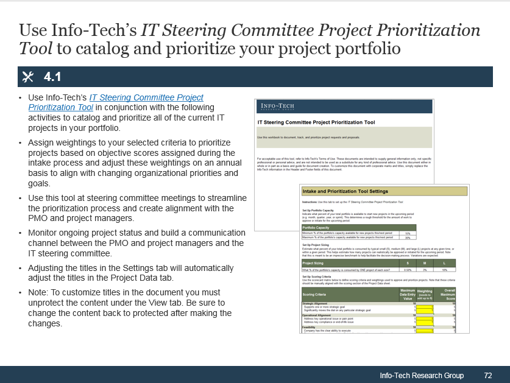 IT Steering Committee Project Prioritization Tool.">
IT Steering Committee Project Prioritization Tool.">
Define your prioritization criteria and customize our IT Steering Committee Project Prioritization Tool
With the help of Info-Tech advisors, create criteria for determining a project’s priority. Customize the tool to reflect the criteria and their weighting. Run pilot tests of the tool to verify the criteria and enter your current project portfolio.
Research contributors and experts
- Andy Lomasky, Manager, Technology & Management Consulting, McGladrey LLP
- Angie Embree, CIO, Best Friends Animal Society
- Corinne Bell, CTO and Director of IT Services, Landmark College
- John Hanskenecht, Director of Technology, University of Detroit Jesuit High School and Academy
- Lori Baker, CIO, Village of Northbrook
- Lynne Allard, IT Supervisor, Nipissing Parry Sound Catholic School Board
- Norman Allen, Senior IT Manager, Baker Tilly
- Paul Martinello, VP, IT Services, Cambridge and North Dumfries Hydro Inc.
- Renee Martinez, IT Director/CIO, City of Santa Fe
- Sam Wong, Director, IT, Seneca College
- Suzanne Barnes, Director, Information Systems, Pathfinder International
- Walt Joyce, CTO, Peoples Bank
Appendices
GOVERNANCE & ITSC & IT Management
Organizations often blur the line between governance and management, resulting in the business having say over the wrong things. Understand the differences and make sure both groups understand their role.
The ITSC is the most senior body within the IT governance structure, involving key business executives and focusing on critical strategic decisions impacting the whole organization.
Within a holistic governance structure, organizations may have additional committees that evaluate, direct, and monitor key decisions at a more tactical level and report into the ITSC.
These committees require specialized knowledge and are implemented to meet specific organizational needs. Those operational committees may spark a tactical task force to act on specific needs.
IT management is responsible for executing on, running, and monitoring strategic activities as determined by IT governance.
| Strategic | IT Steering Committee | |
| Tactical | Project Governance Service Governance Risk Governance Information Governance | IT Management |
| Operational | Risk Task Force |
This blueprint focuses exclusively on building the IT Steering committee. For more information on IT governance see Info-Tech’s related blueprint: Tailor an IT Governance Plan to Fit Organizational Needs.
IT steering committees play an important role in IT governance
By bucketing responsibilities into these areas, you’ll be able to account for most key IT decisions and help the business to understand their role in governance, fostering ownership and joint accountability.
The five governance areas are:
Governance of the IT Portfolio and Investments: Ensures that funding and resources are systematically allocated to the priority projects that deliver value.
Governance of Projects: Ensures that IT projects deliver the expected value, and that the PM methodology is measured and effective.
Governance of Risks: Ensures the organization’s ability to assess and deliver IT projects and services with acceptable risk.
Governance of Services: Ensures that IT delivers the required services at the acceptable performance levels.
Governance of Information and Data: Ensures the appropriate classification and retention of data based on business need.
A survey of stakeholders identified a need for increased stakeholder involvement and transparency in decision making
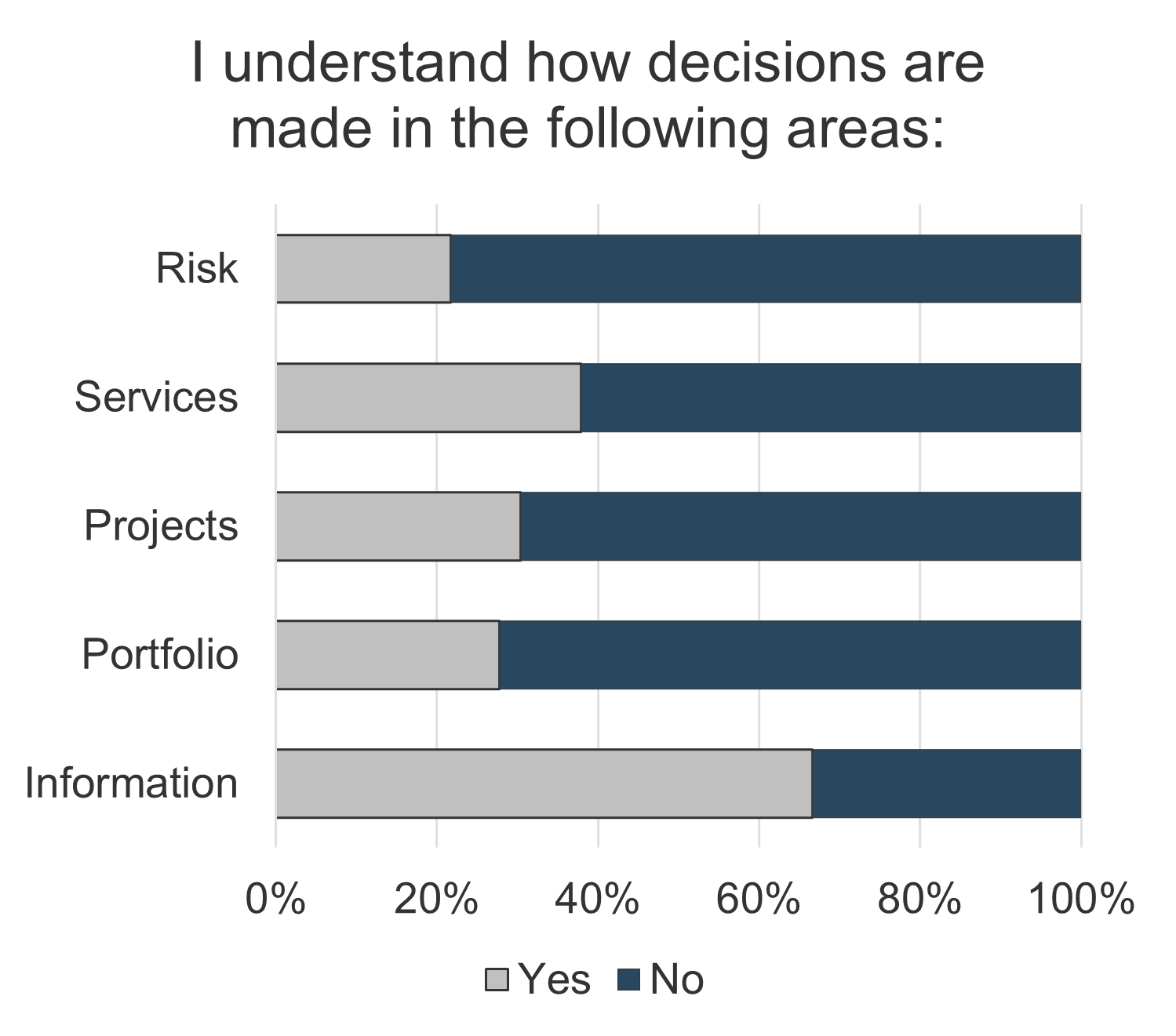
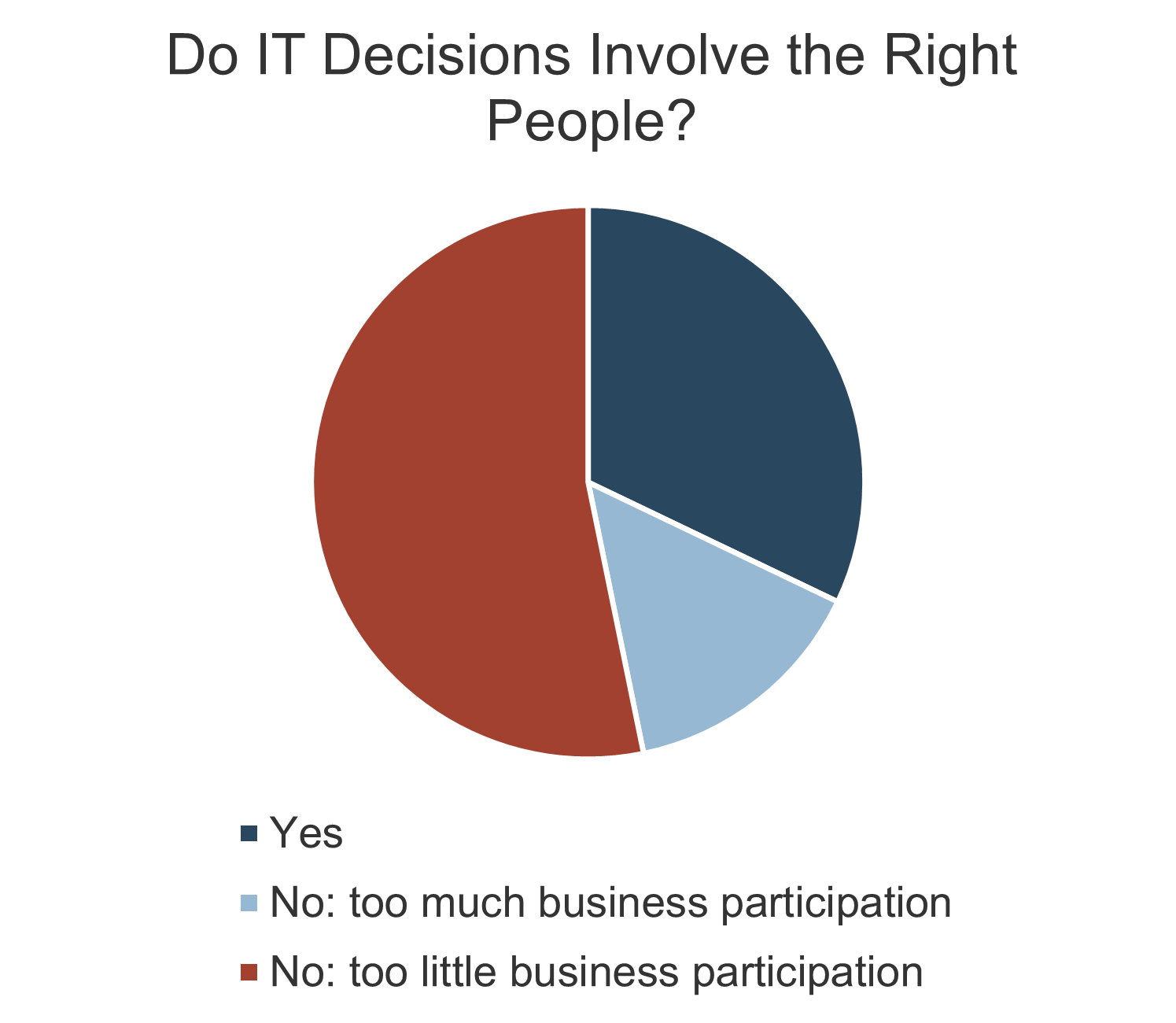
Overall, survey respondents indicated a lack of understanding about how decisions are made around risk, services, projects, and investments, and that business involvement in decision making was too minimal.
Satisfaction with decision quality around investments and PPM are uneven and largely not well understood
72% of stakeholders do not understand how decisions around IT services are made (quality, availability, etc.).
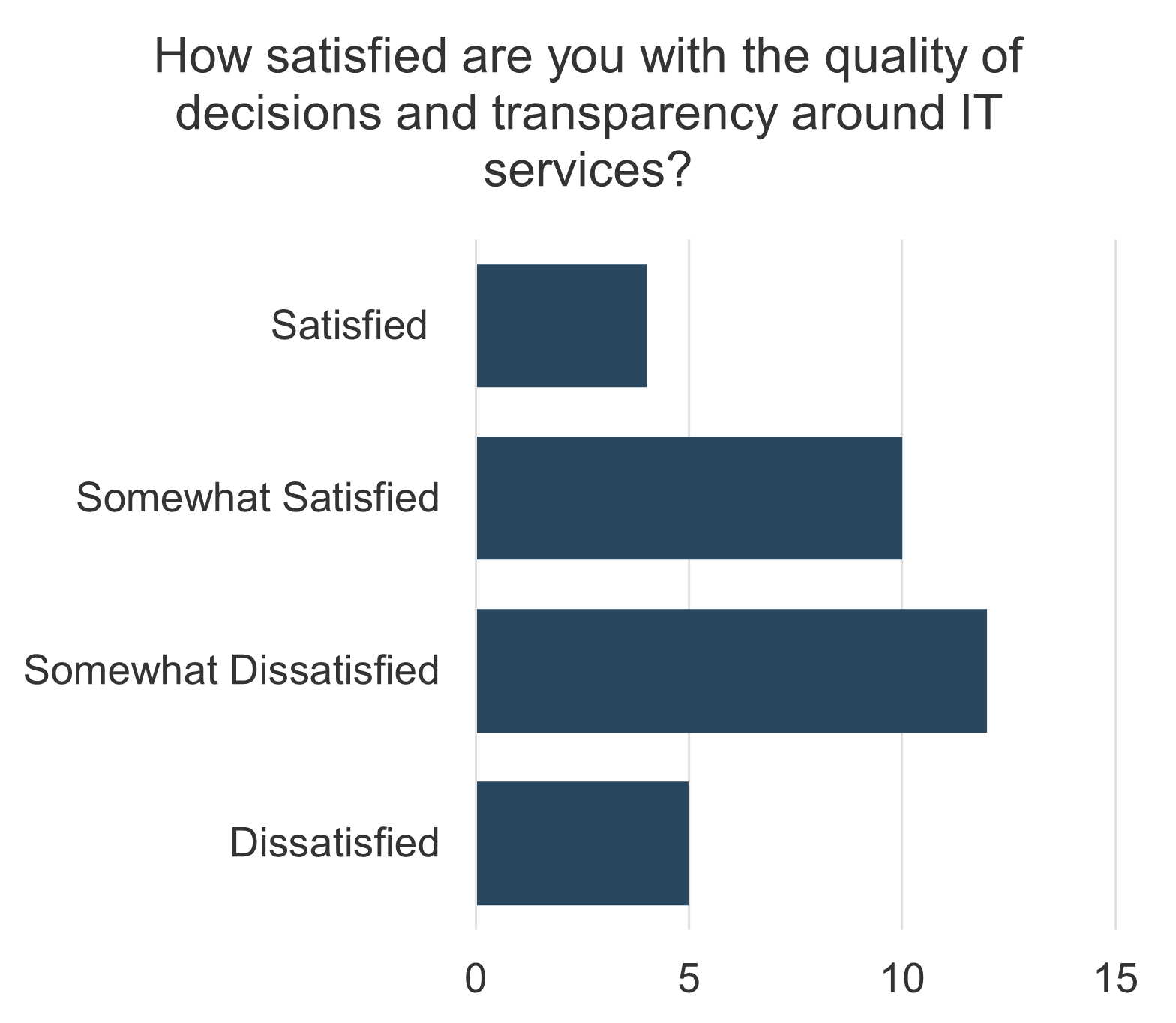
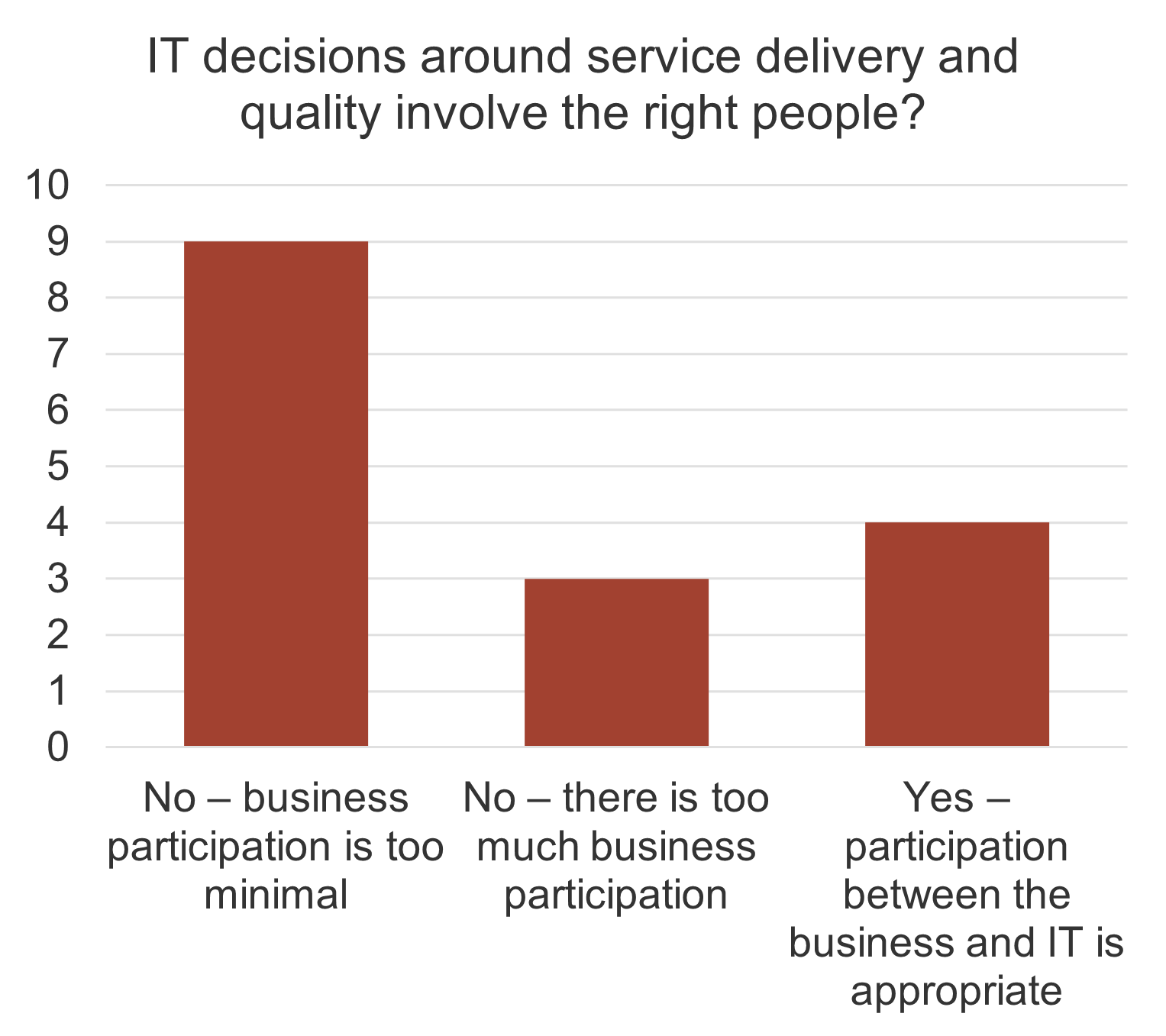
Overall, services were ranked #1 in importance of the 5 areas
62% of stakeholders do not understand how decisions around IT services are made (quality, availability, etc.).
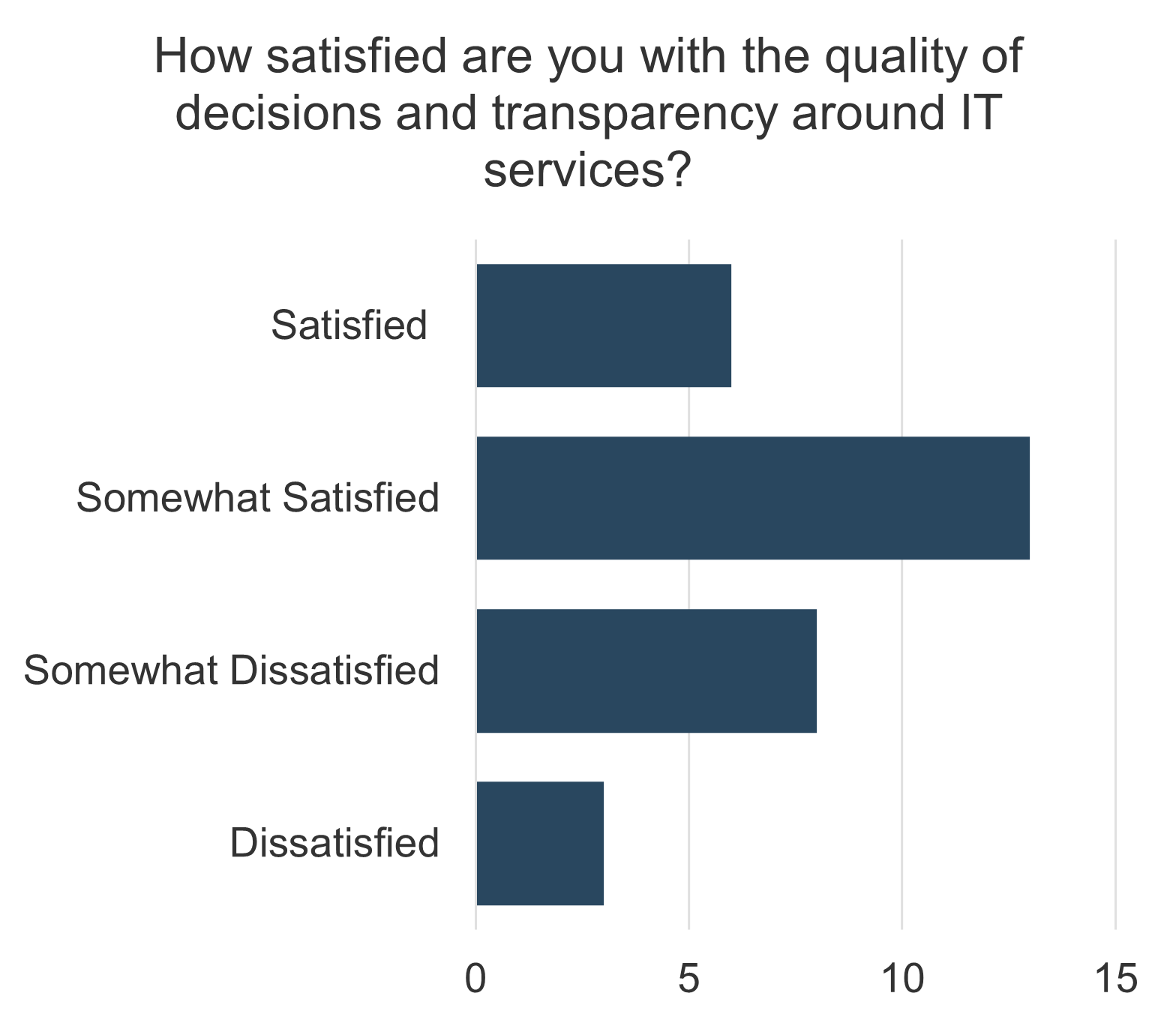

Projects ranked as one of the areas with which participants are most satisfied with the quality of decisions
70% of stakeholders do not understand how decisions around projects selection, success, and changes are made.
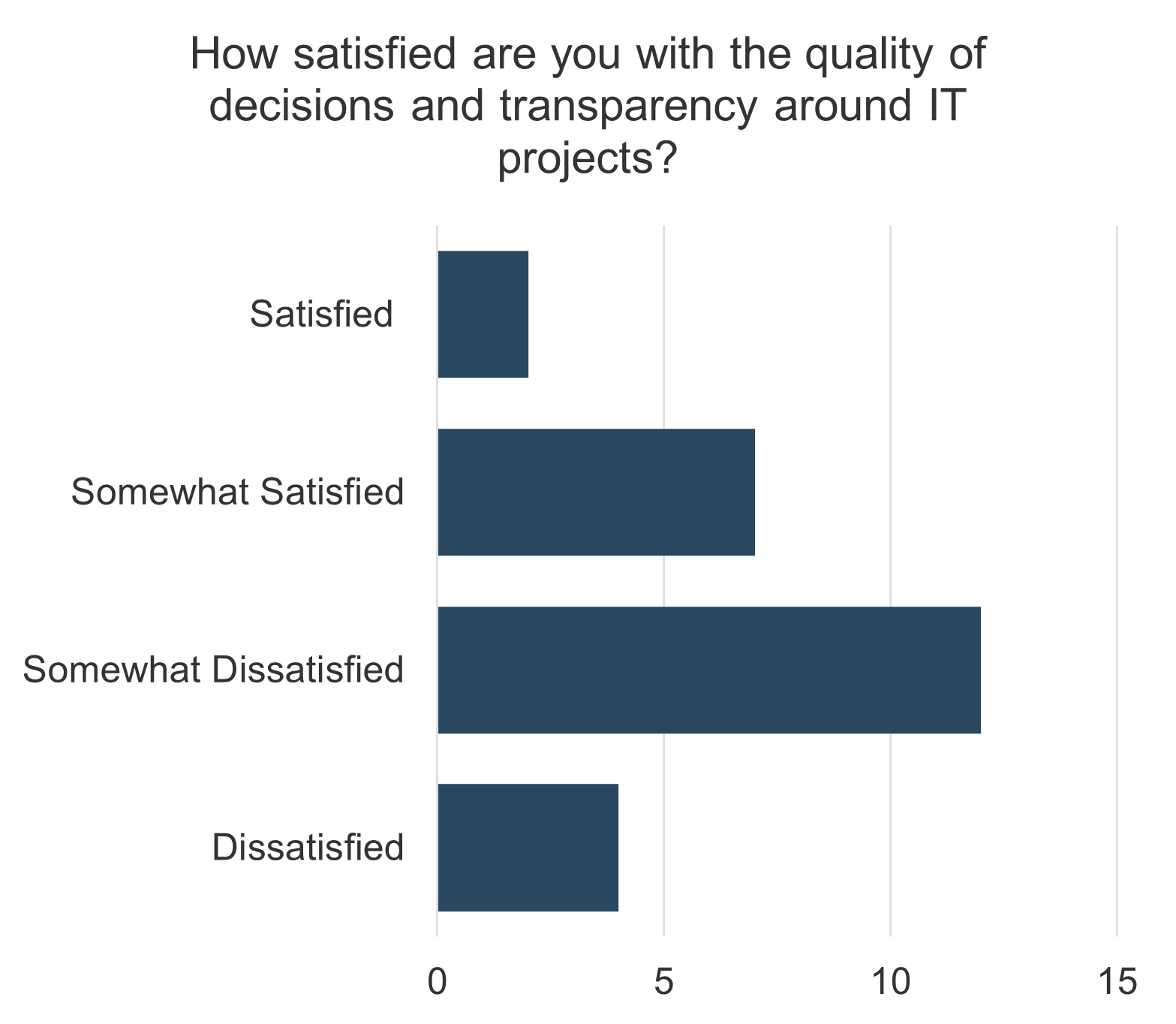
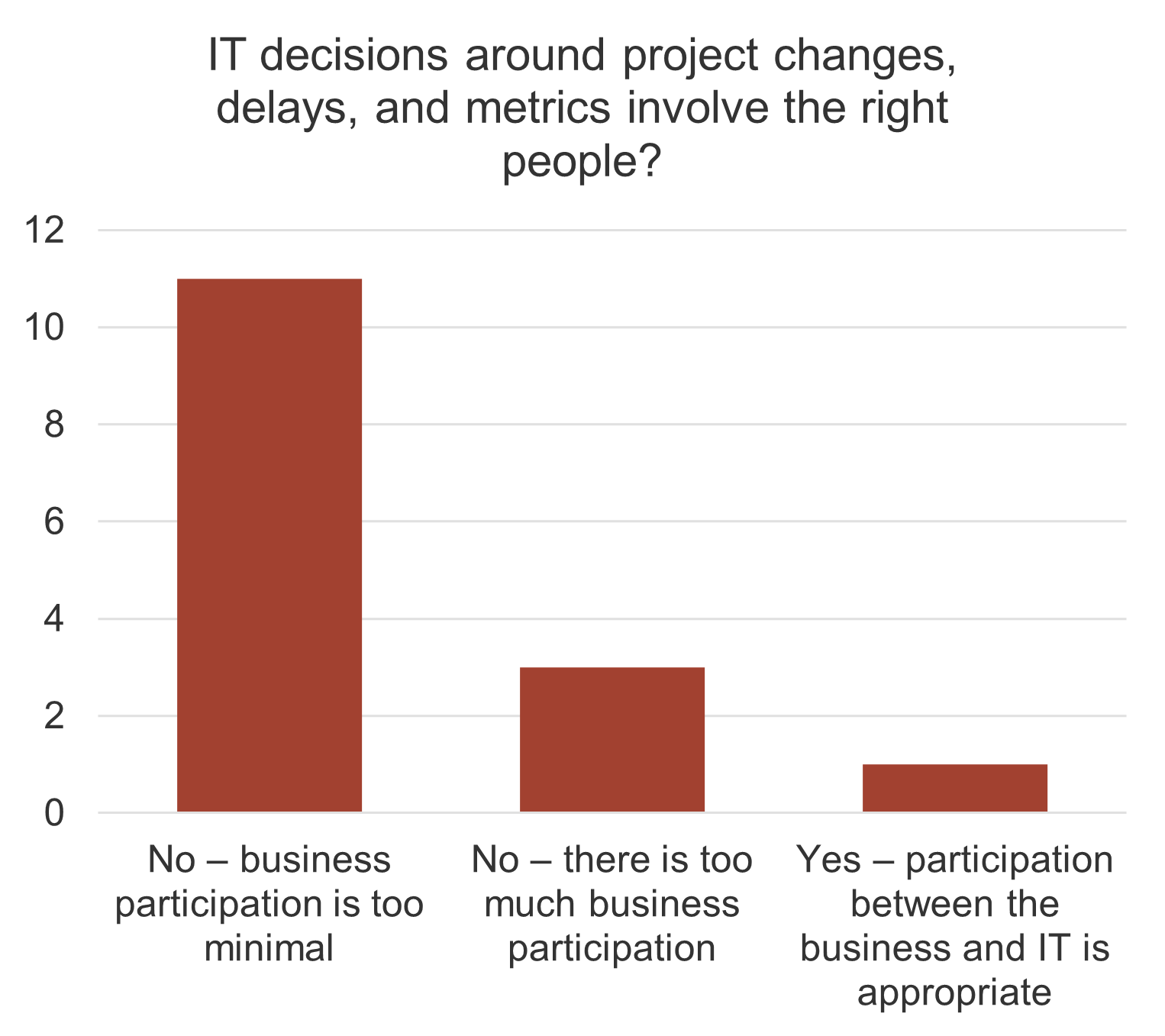
Stakeholders are largely unaware of how decisions around risk are made and believe business participation needs to increase
78% of stakeholders do not understand how decisions around risk are made
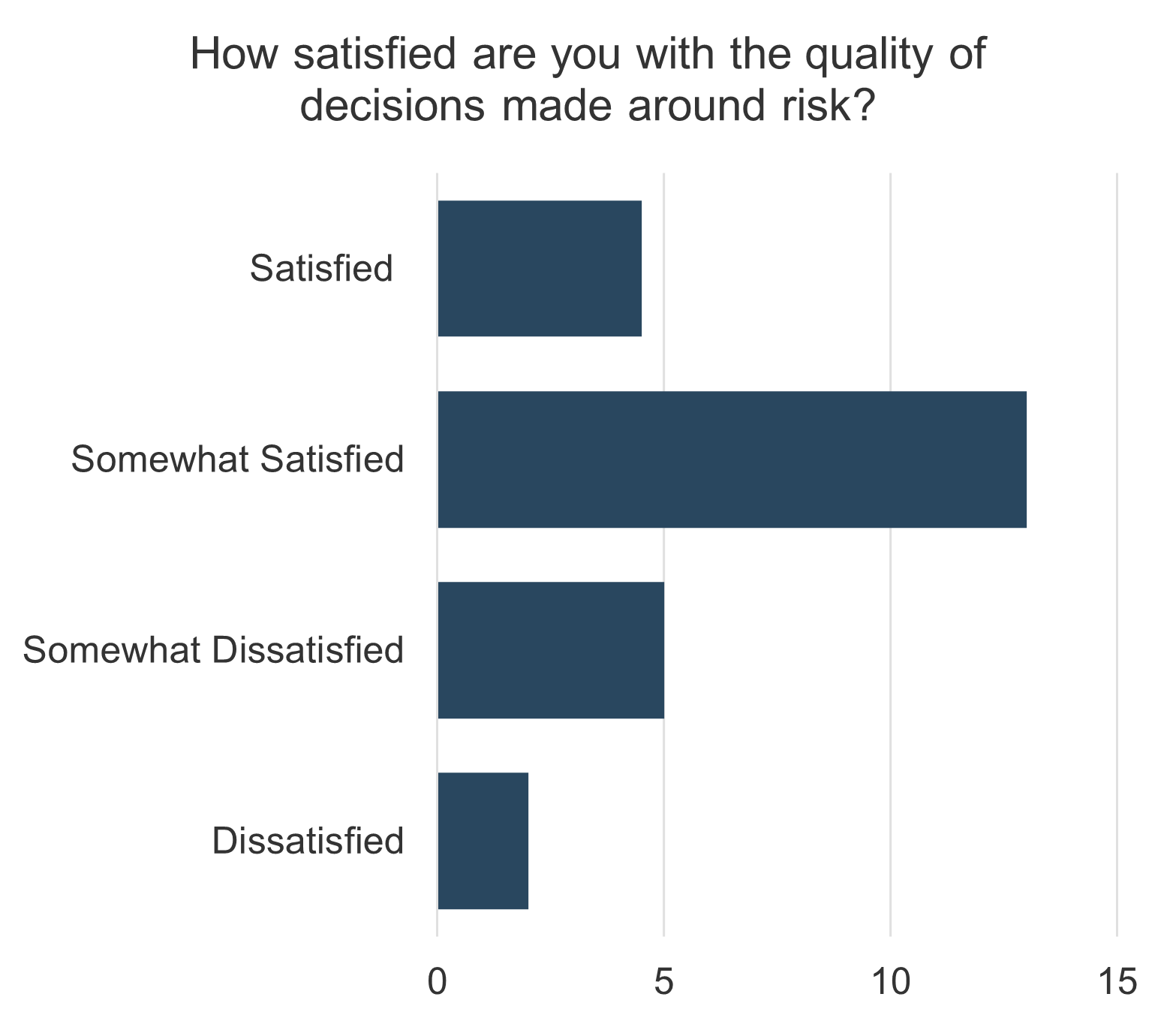

The majority of stakeholders believe that they are aware of how decisions around information are made
67% of stakeholders believe they do understand how decisions around information (data) retention and classification are made.
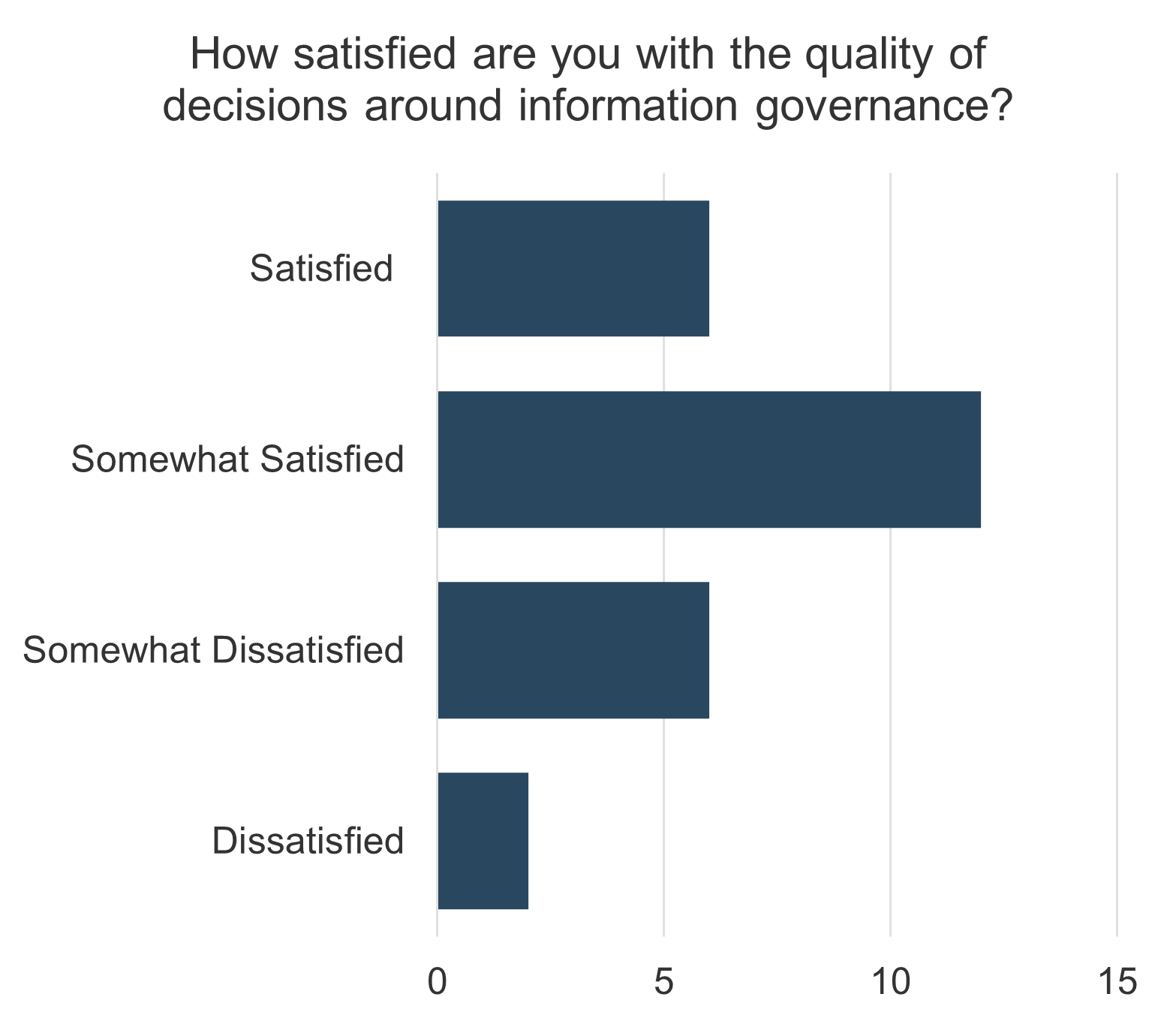
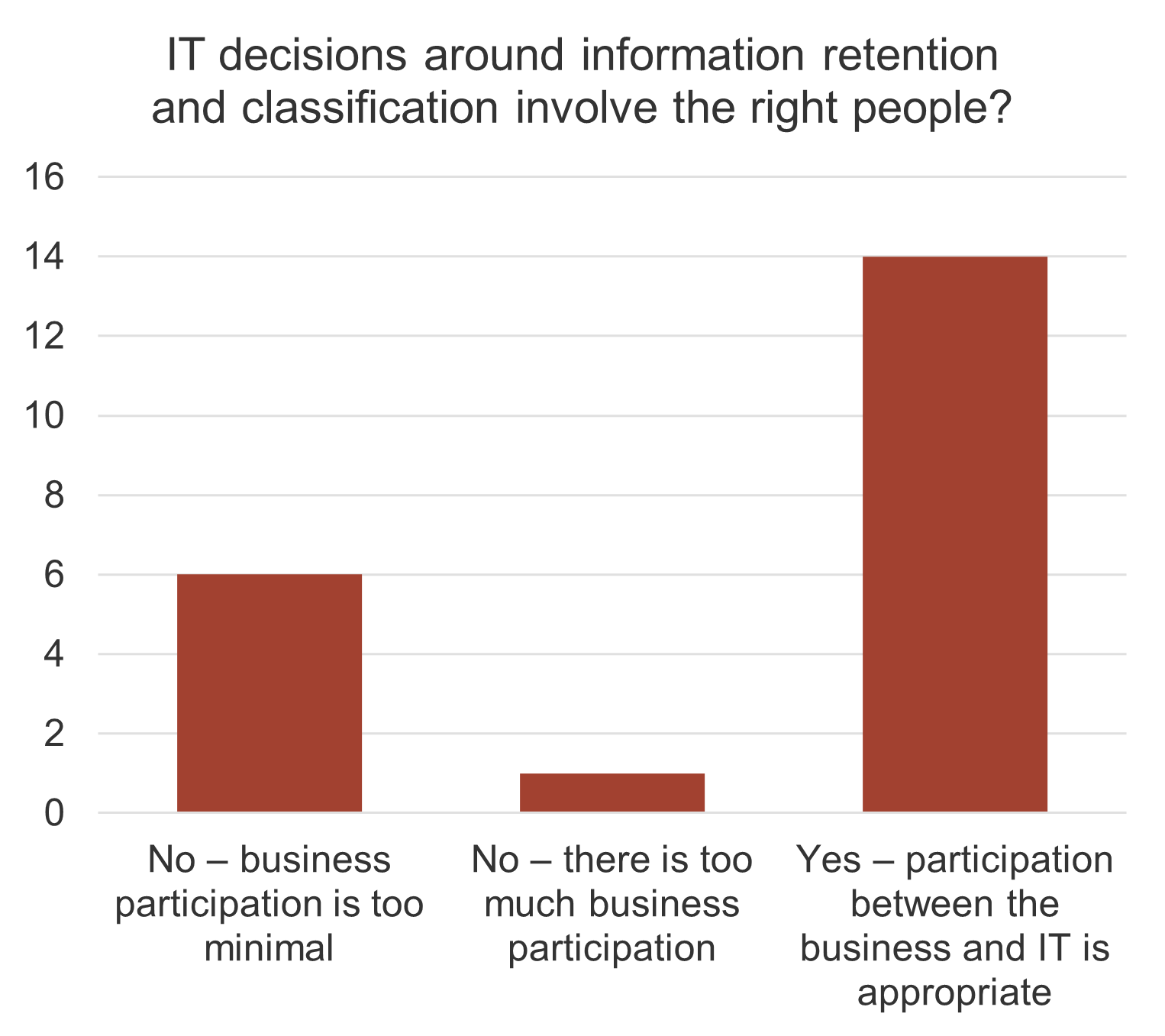
Buying Options
Establish an Effective IT Steering Committee
Client rating
Cost Savings
Days Saved
IT Risk Management · IT Leadership & Strategy implementation · Operational Management · Service Delivery · Organizational Management · Process Improvements · ITIL, CORM, Agile · Cost Control · Business Process Analysis · Technology Development · Project Implementation · International Coordination · In & Outsourcing · Customer Care · Multilingual: Dutch, English, French, German, Japanese · Entrepreneur
Tymans Group is a brand by Gert Taeymans BV
Gert Taeymans bv
Europe: Koning Albertstraat 136, 2070 Burcht, Belgium — VAT No: BE0685.974.694 — phone: +32 (0) 468.142.754
USA: 4023 KENNETT PIKE, SUITE 751, GREENVILLE, DE 19807 — Phone: 1-917-473-8669
Copyright 2017-2022 Gert Taeymans BV